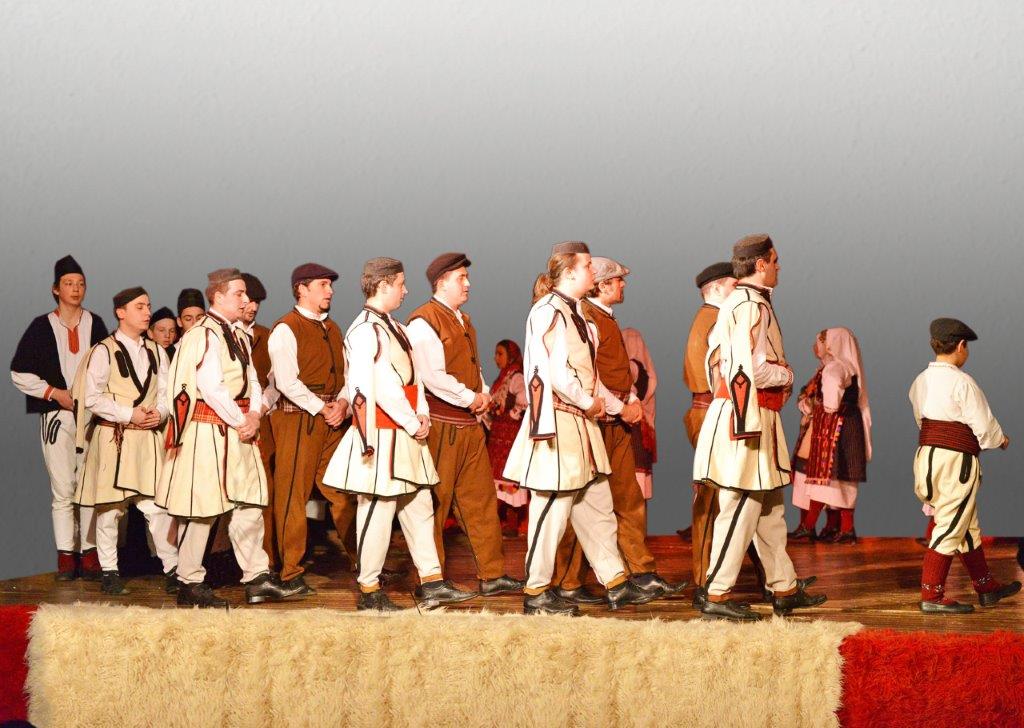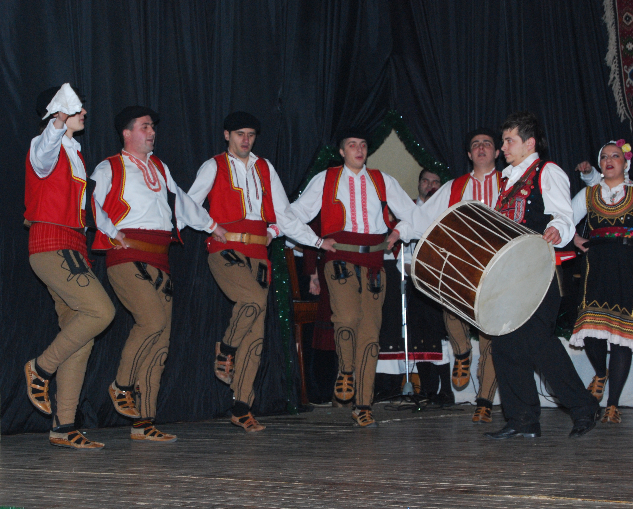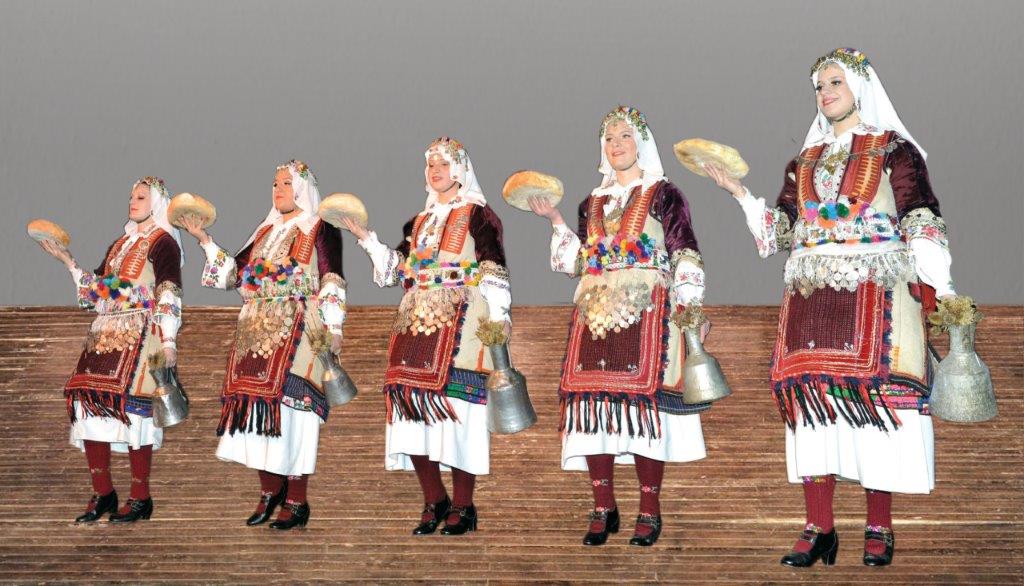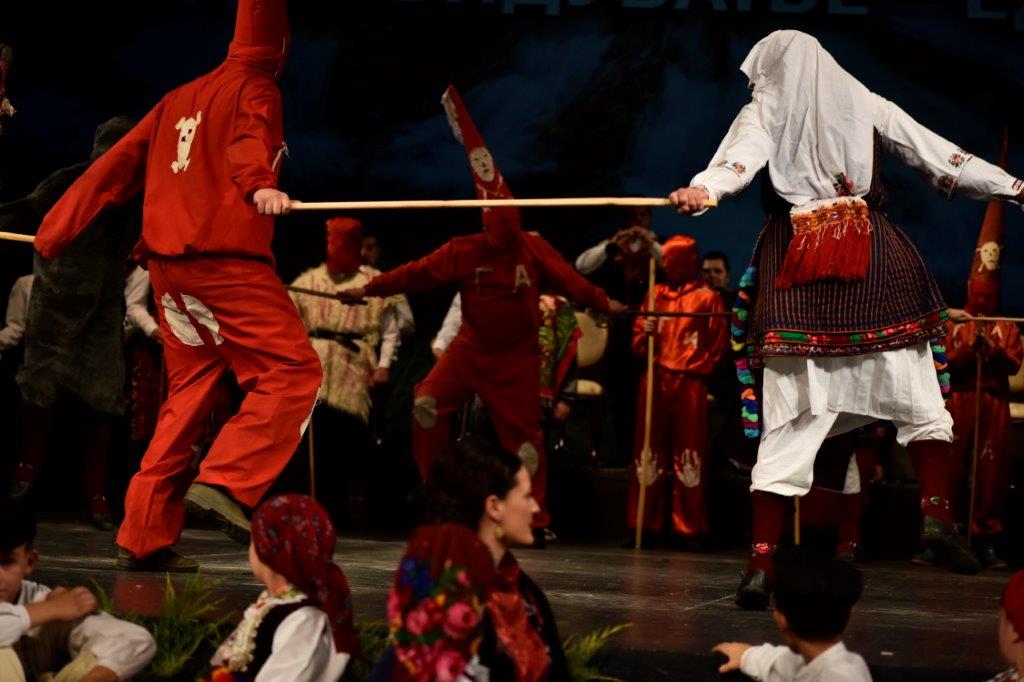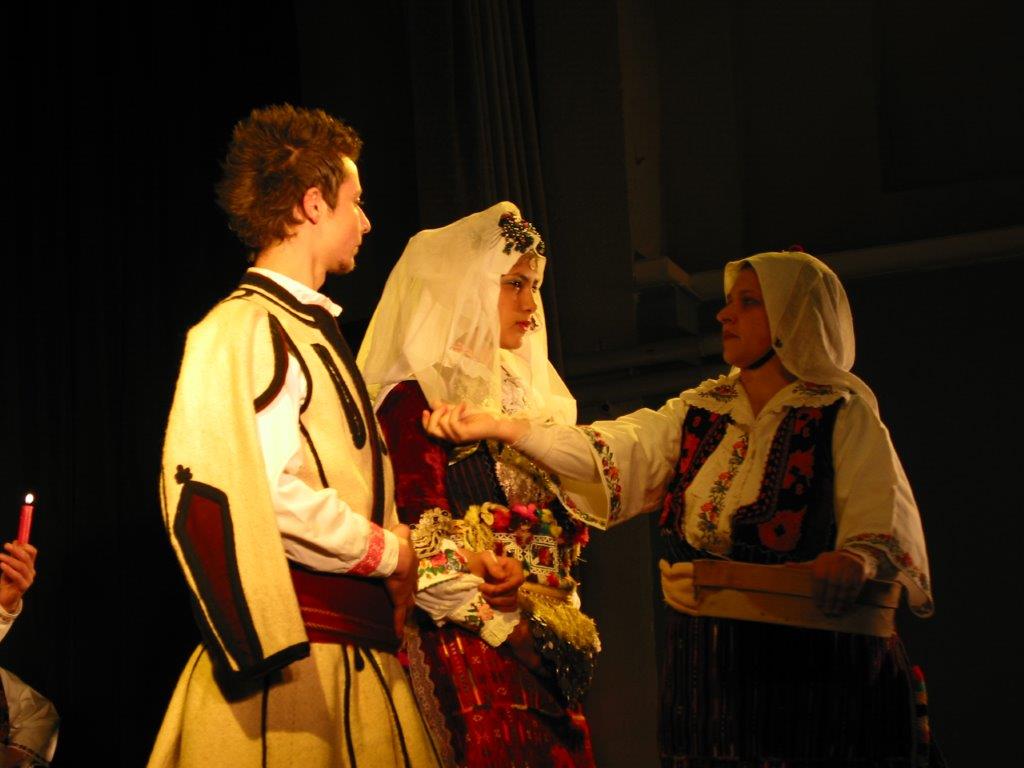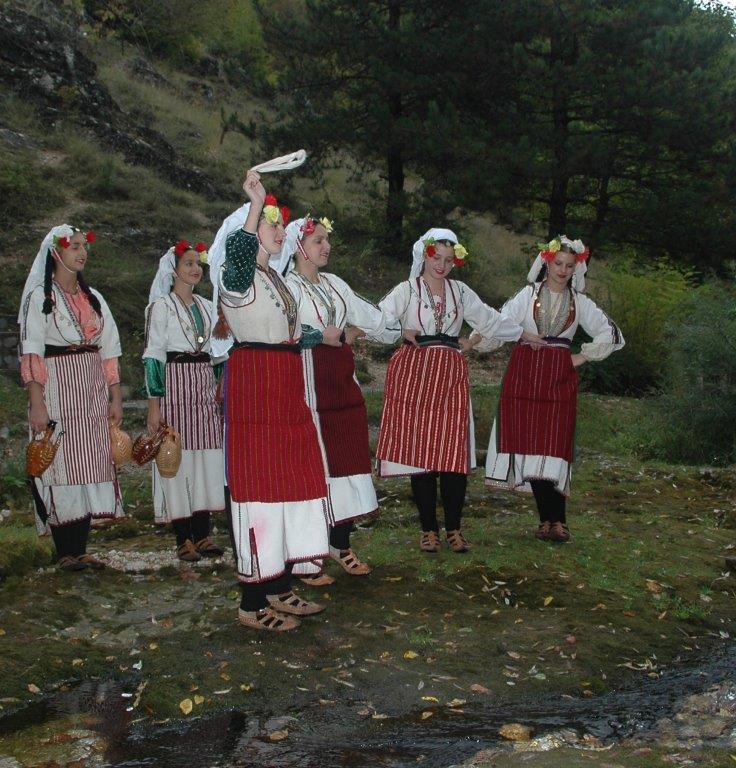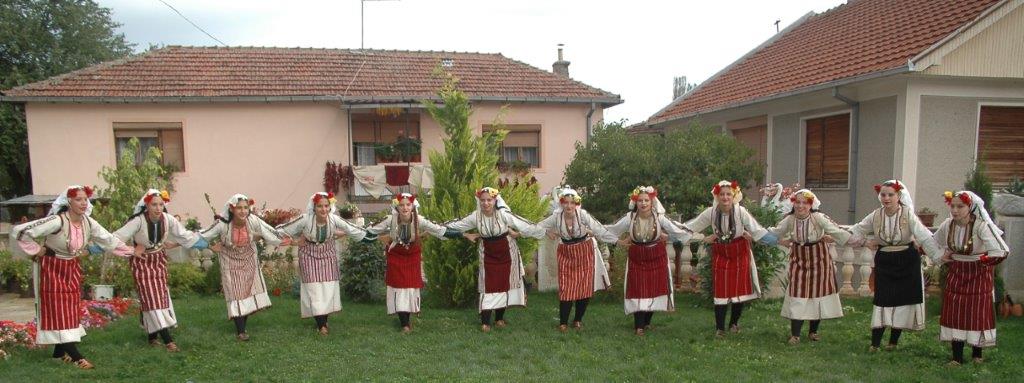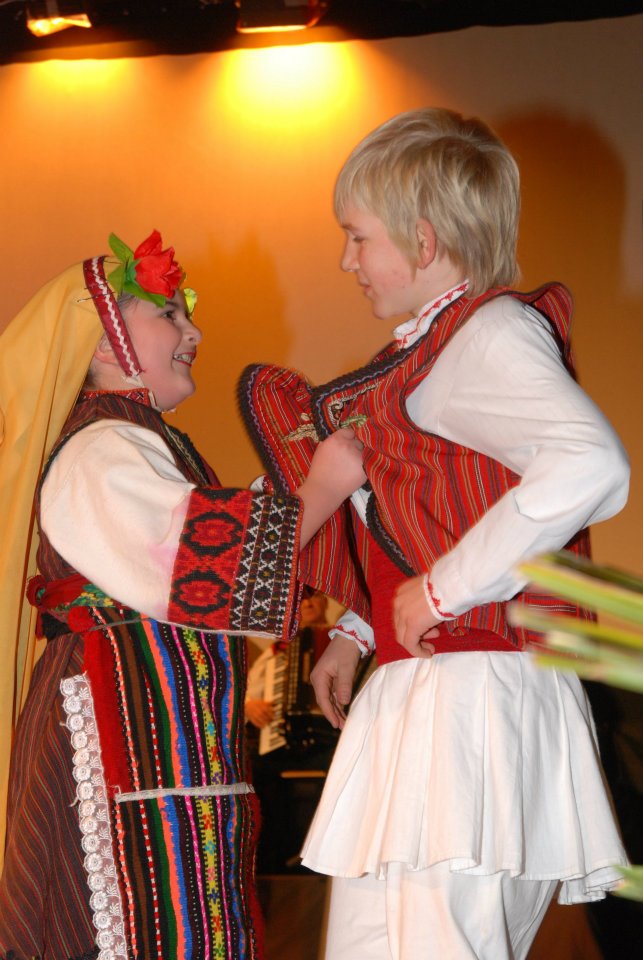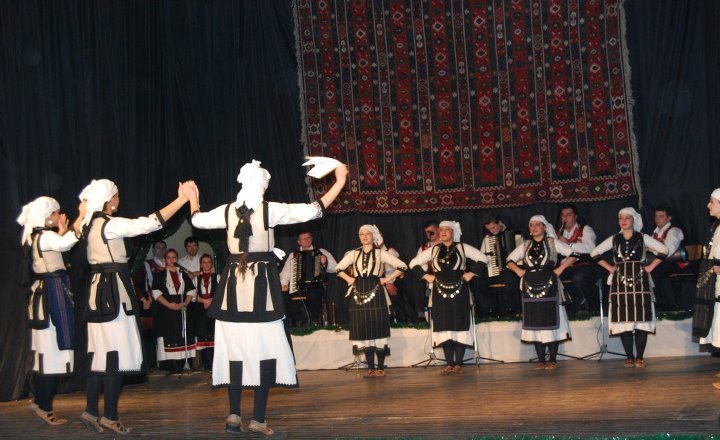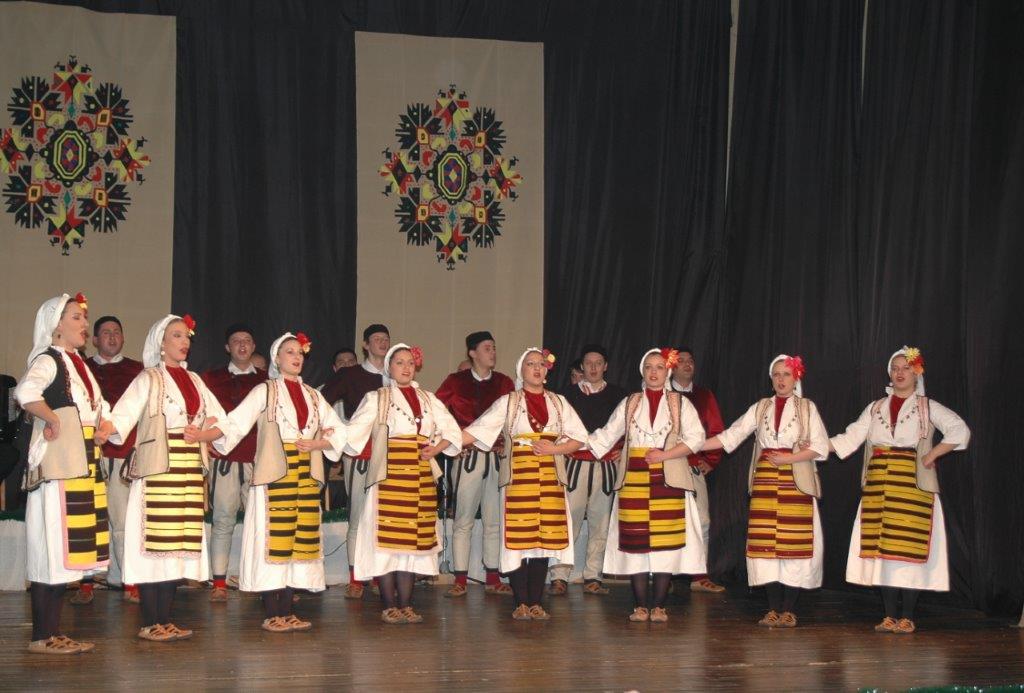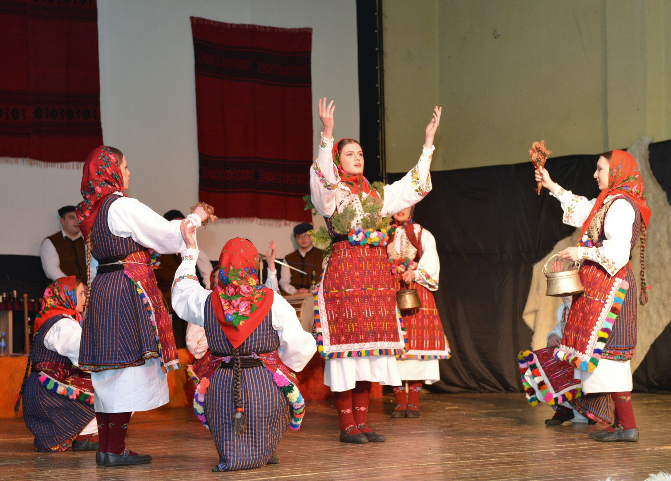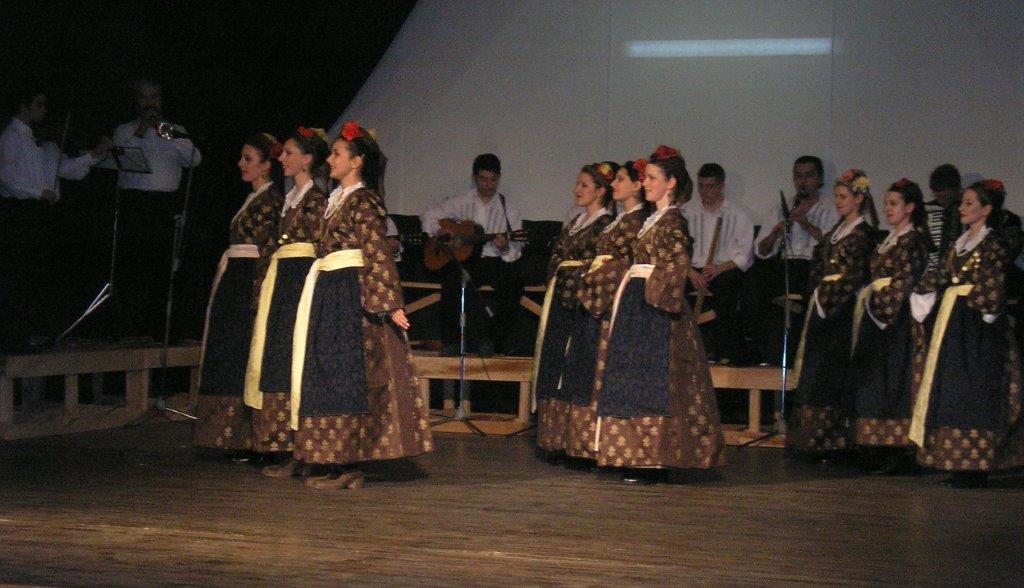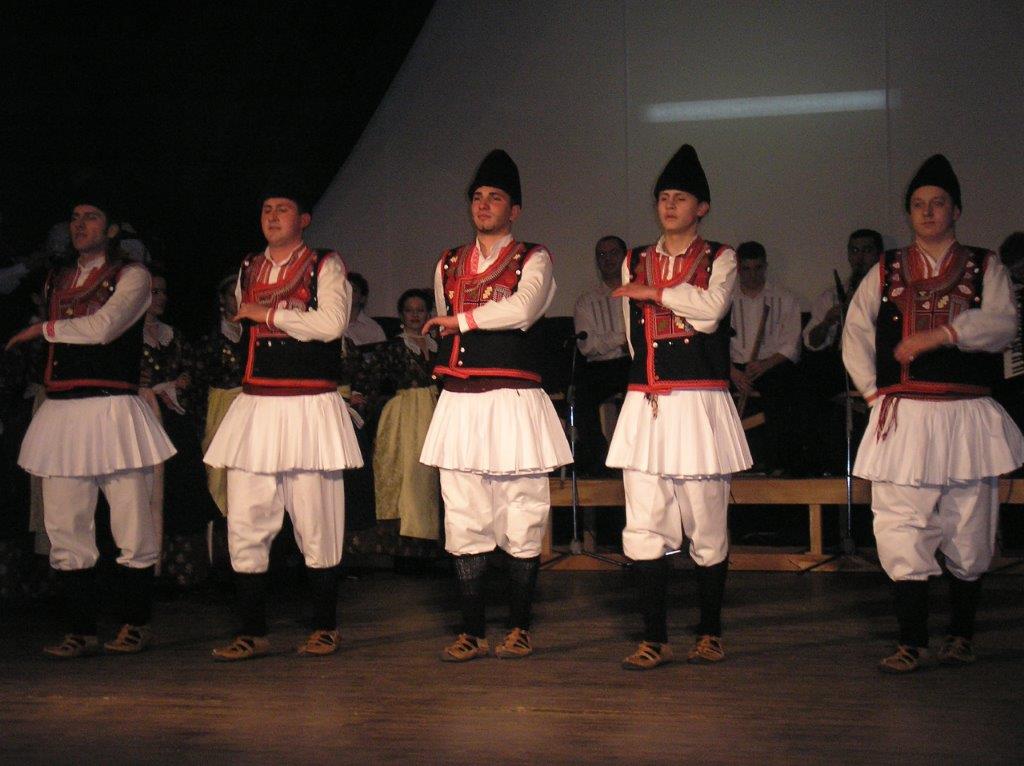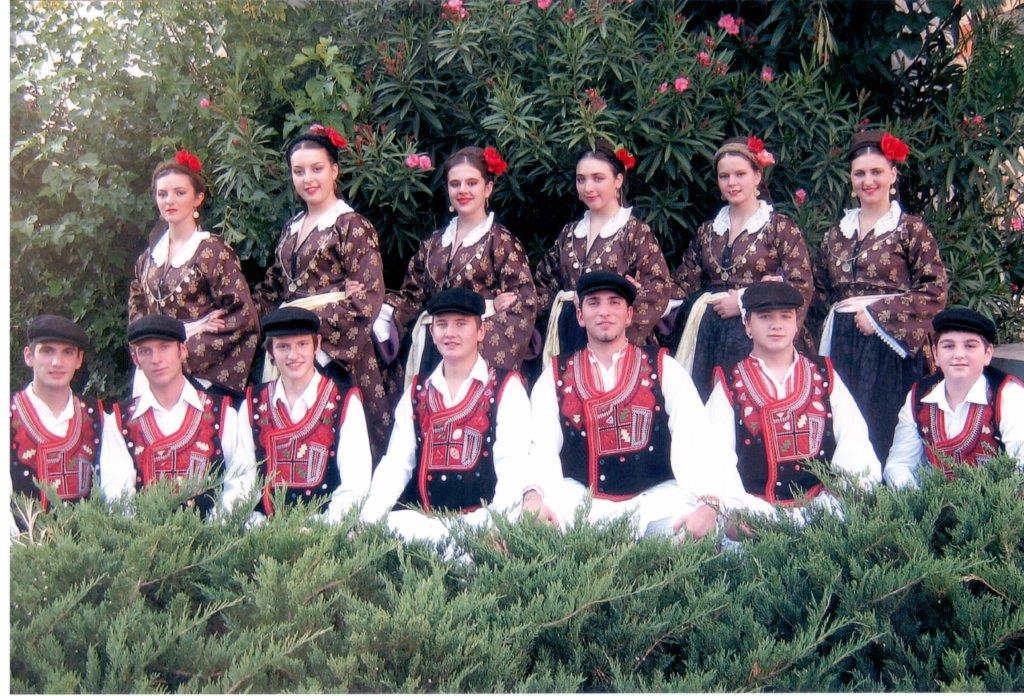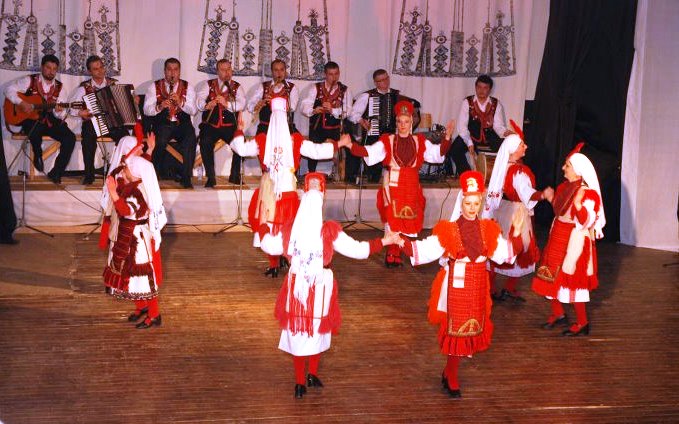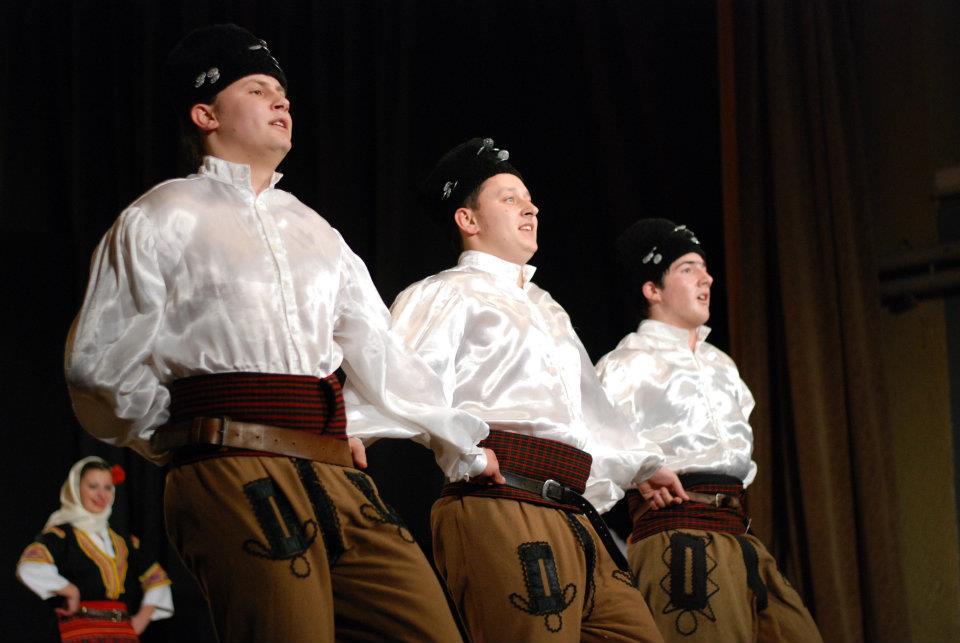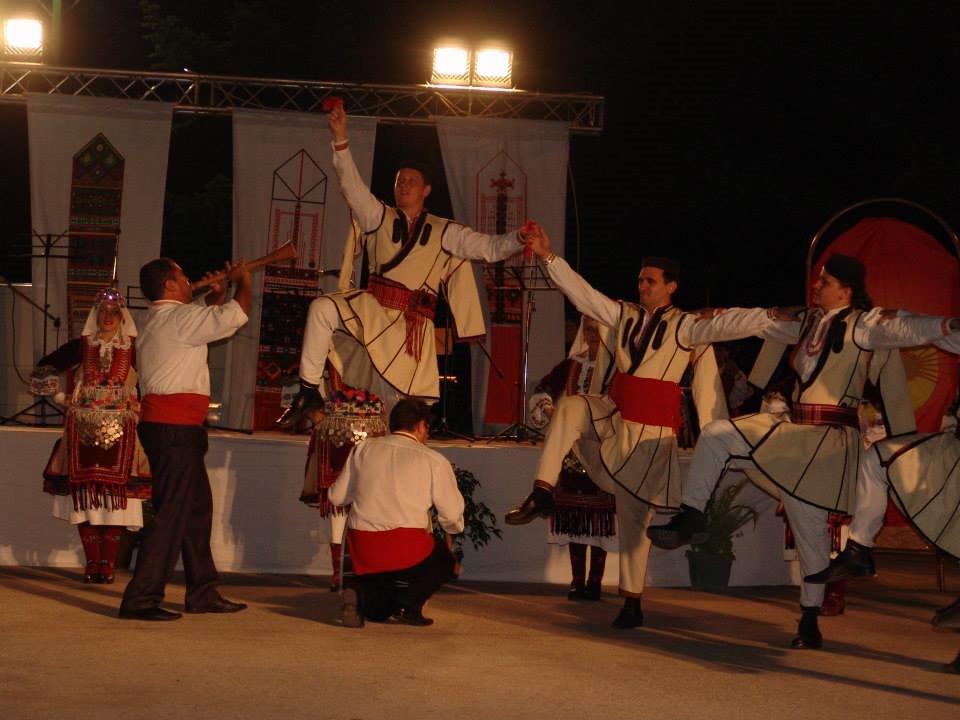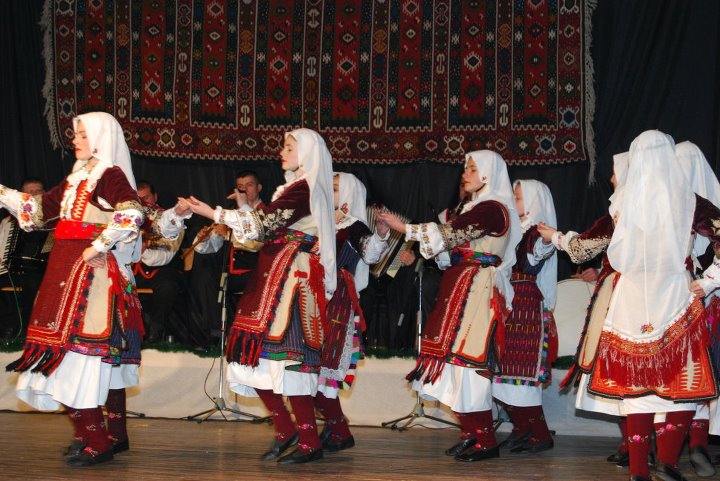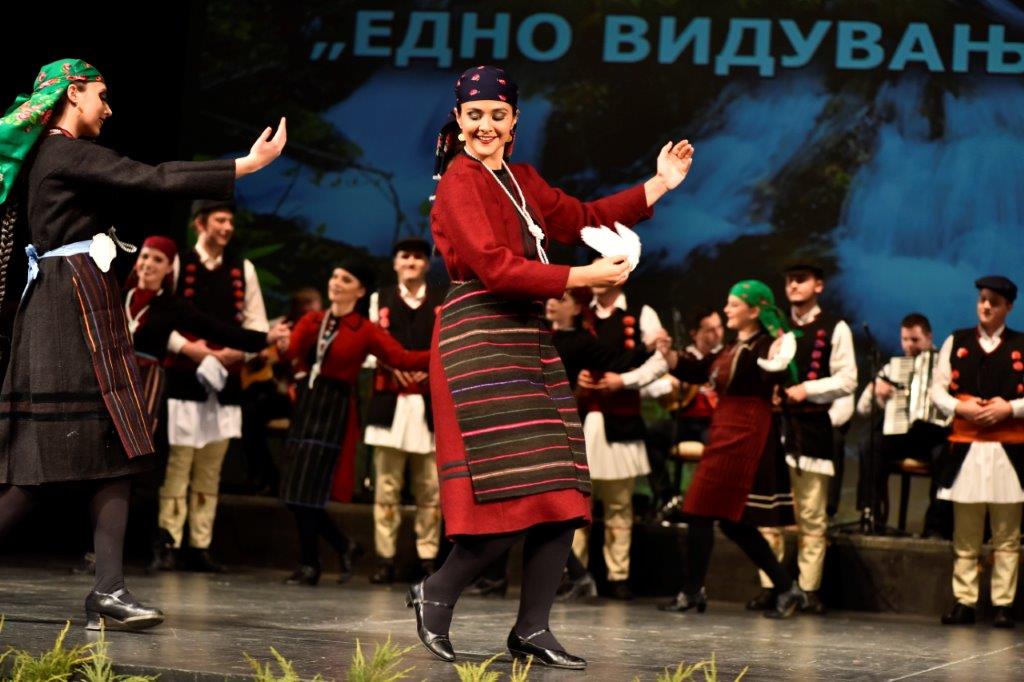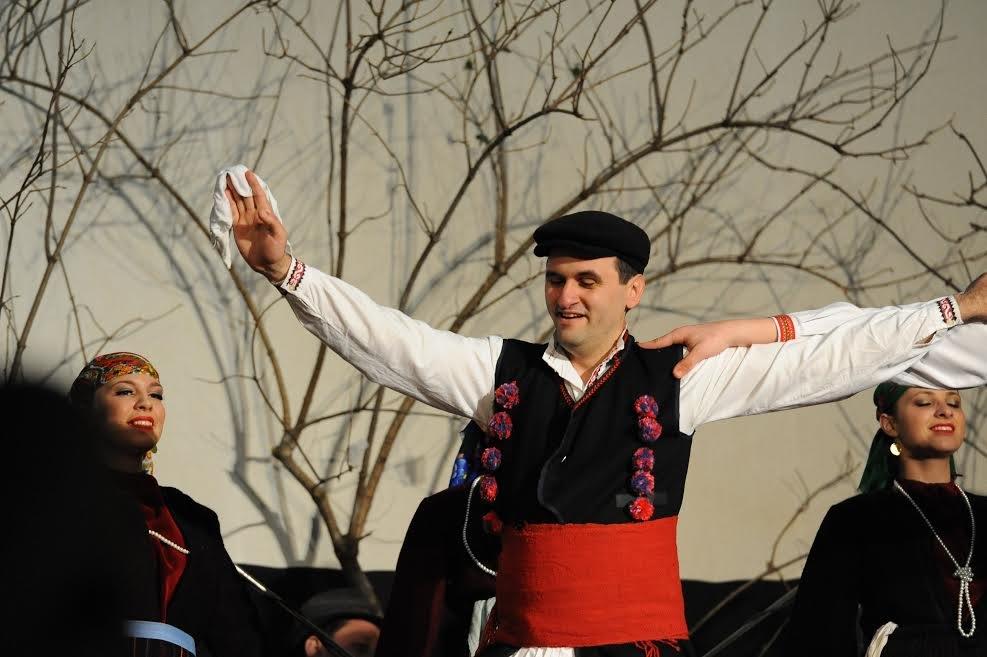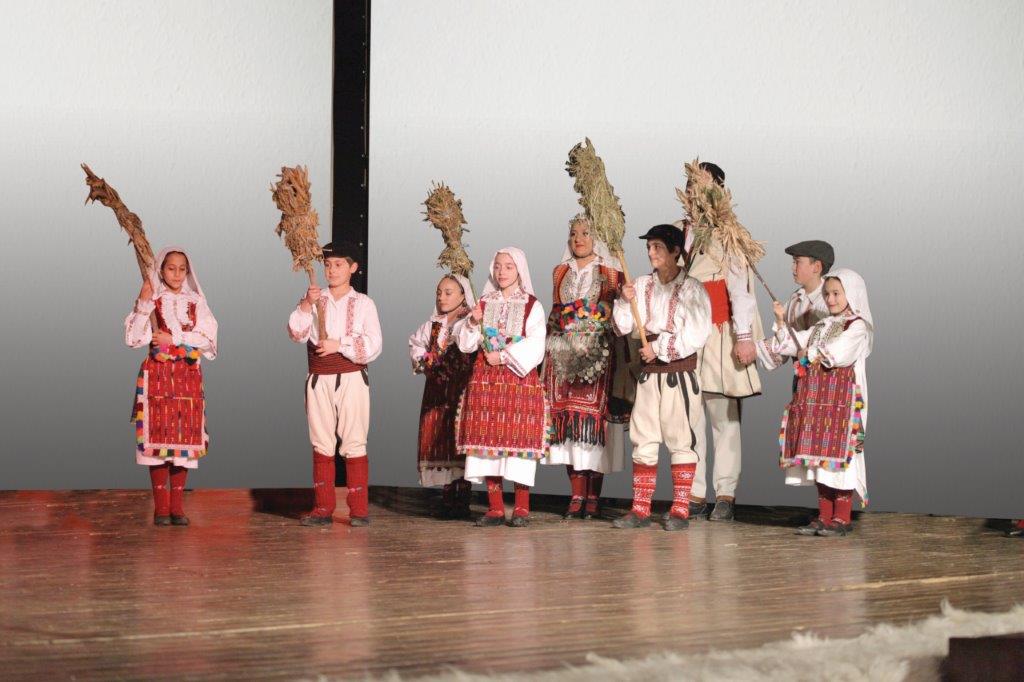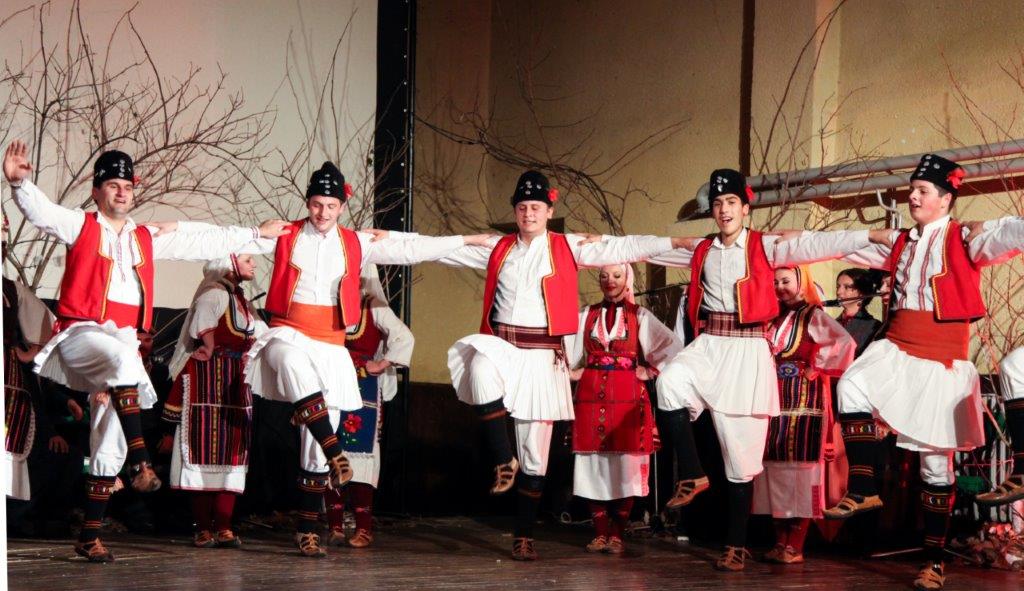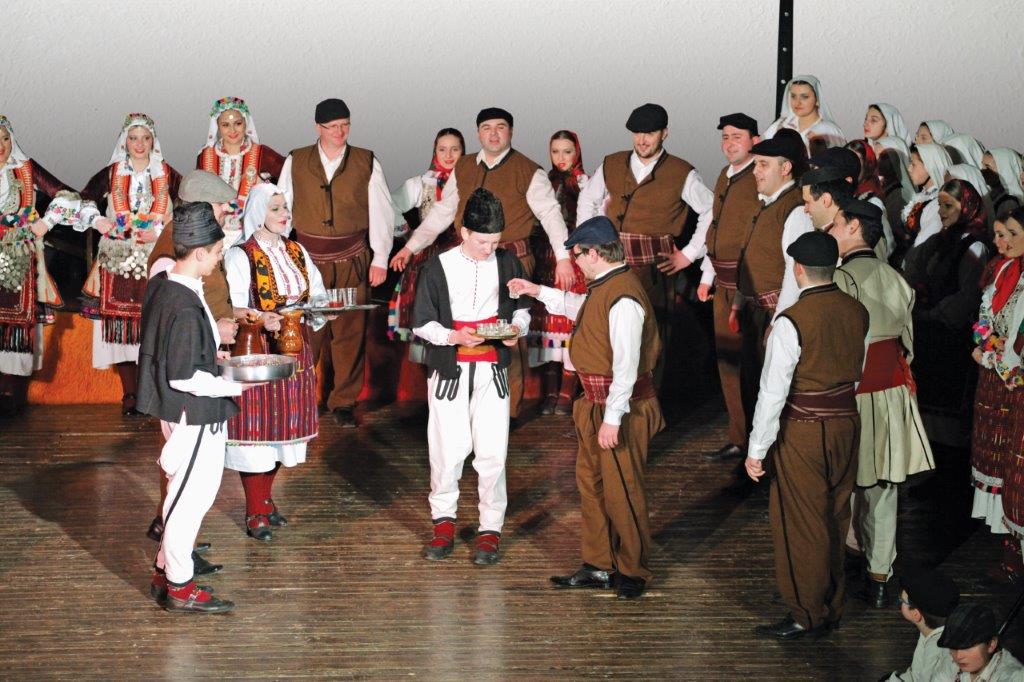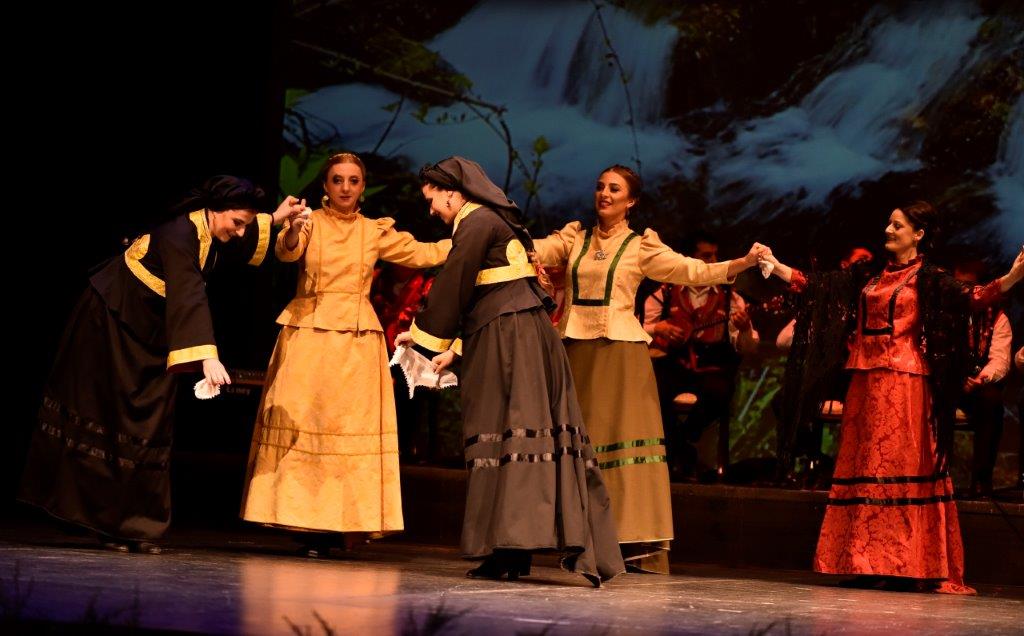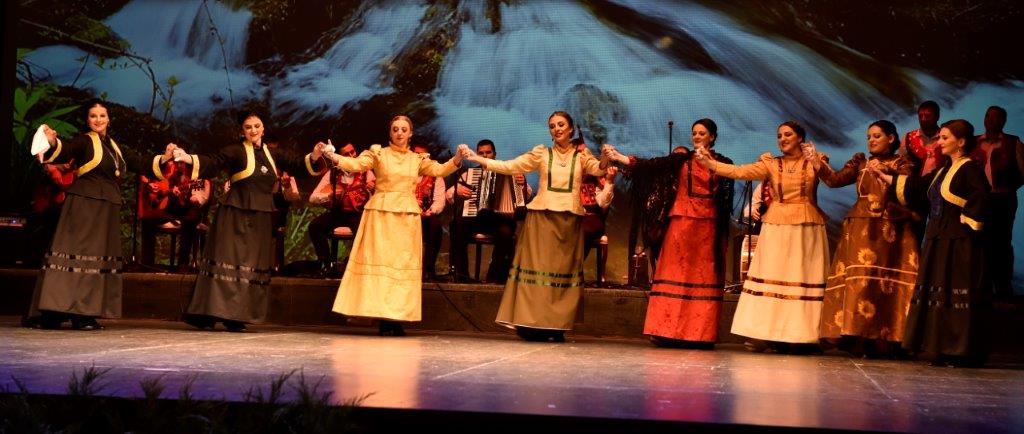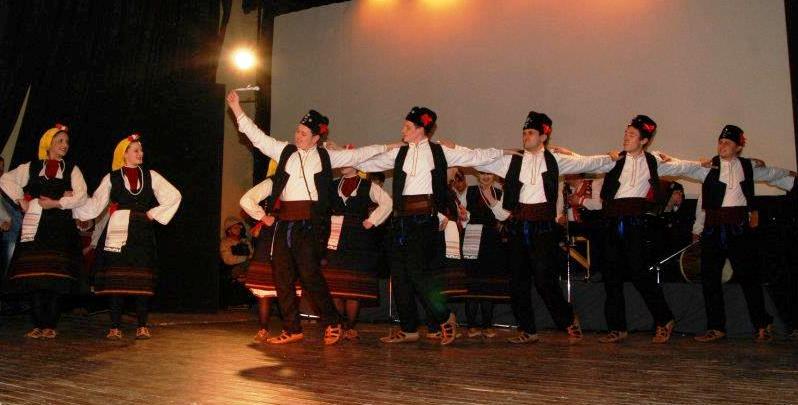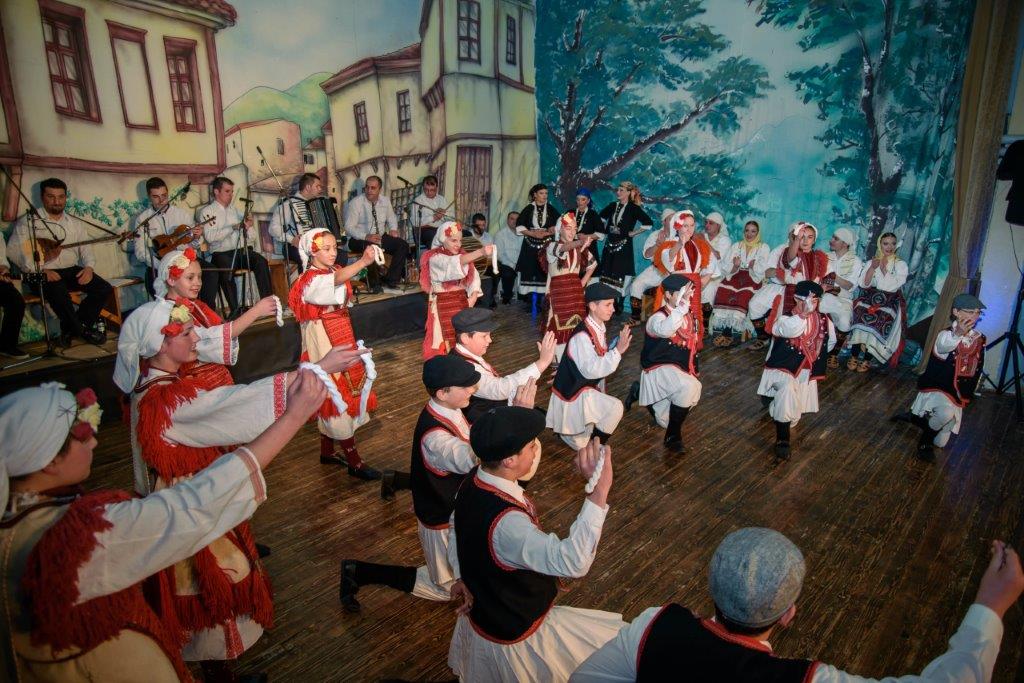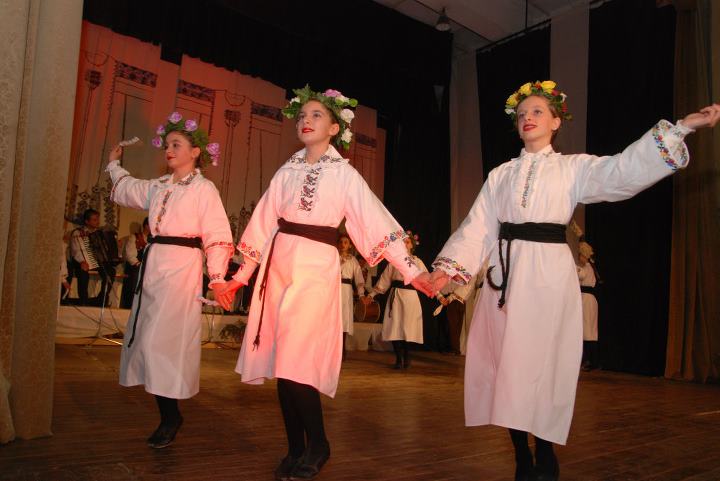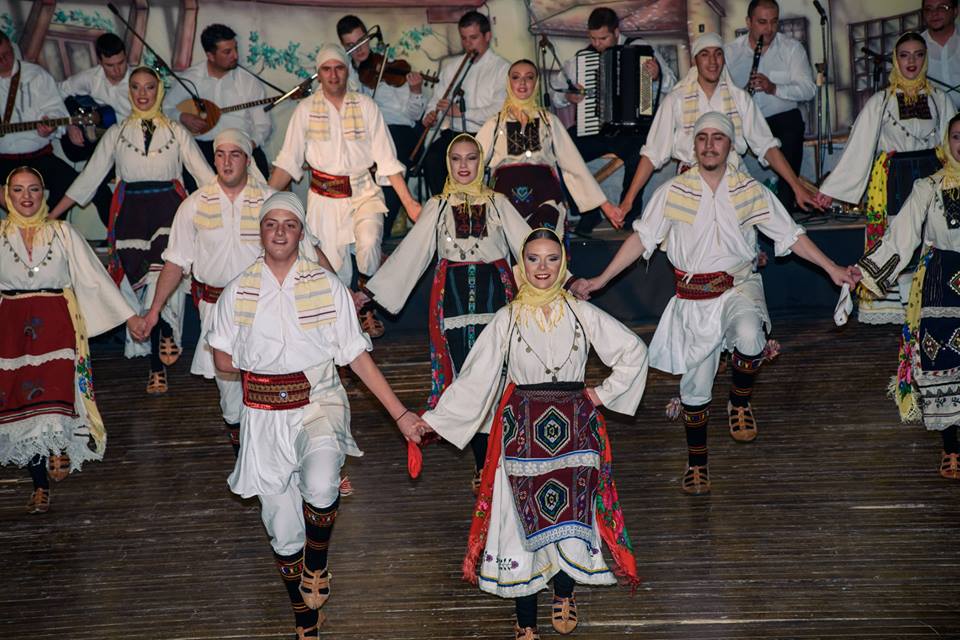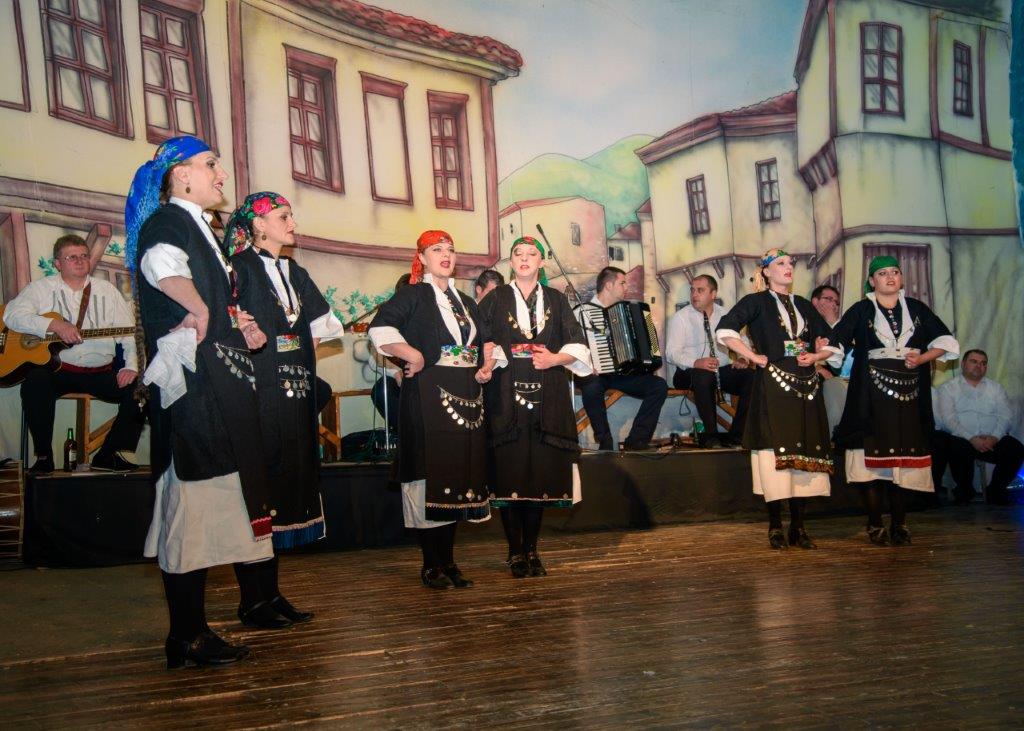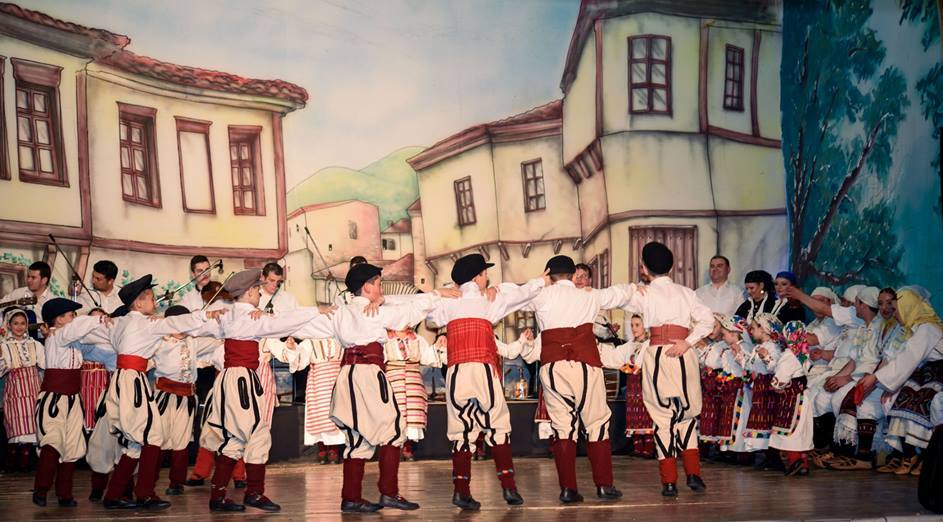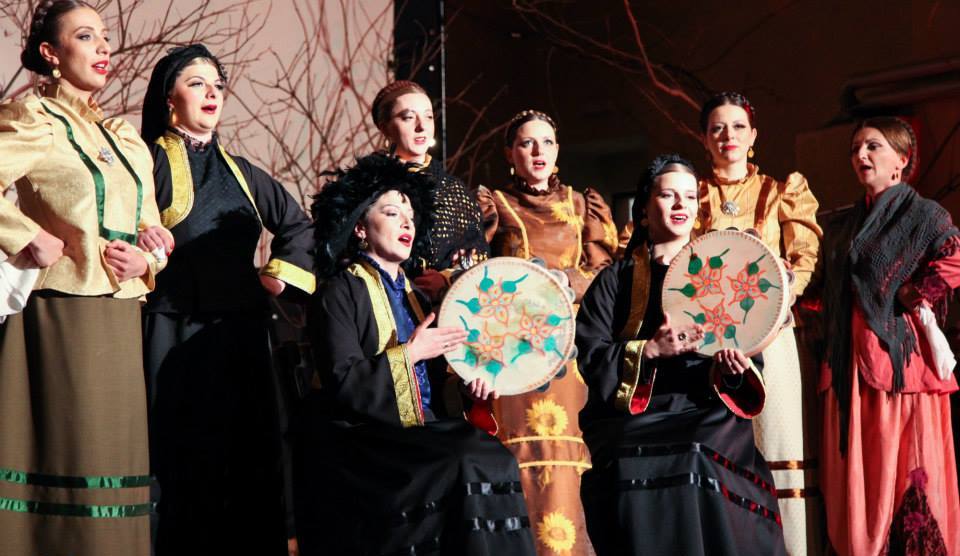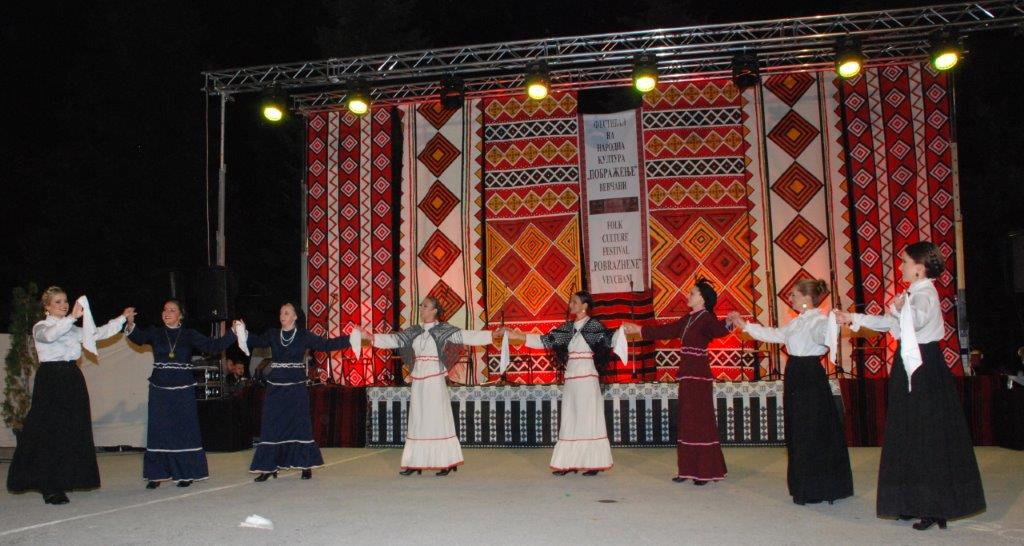1. Vevcani Lazara
Stage adaptation: Tosho Chochoroski
Music Processing: Pero Peshinoski
A male and female dance derived from motives of the religious celebration of Lazarus celebrated in Vevcani. The main characteristic of this holiday is that exclusively in Vevcani it is celebrated as Mens’Lazarus on the Friday and Women’s Lazarus on Saturday.
Converted into a stage adaptation this holiday is displayed through several scenes. The dance by its purpose belongs to a group of ritual dances that is performed in a strictly defined time, place and number of participants, with special props - a basket to collect the gifts, usually egg and coin, and saber or sword, and a determined order of activities during the performance of the dance itself. According to gender, the first group is of male dancers, which symbolizes the holiday Men Lazarus when the boys and young men, the day before Lazarus Saturday, on Friday, used to go from house to house and singing appropriate ritual lazara songs.
It includes appropriate songs and steps specific to the area of origin. They dance dressed in a festive maiden and festive male costumes of Vevcani, and use appropriate paraphernalia with the purpose of presenting authentic stage adaptation and play.

(Gallery)
2. Zensko (female) Chamche
Choreographic treatment: Rafe Zhikovski
Musical treatment: Emil Selim
Female dance, accompanied by traditional instruments. The dancing patern is represented by slow steps filled with grace, humility and dignified movements, showing the beauty, patriarchy and calmness of the Miyak woman. This female dance is performed in Mijack national costume of the villages Papradishte and Smilevo.

(Gallery)
3. Gjurgjovdenski (St. George’s Day) songs and dances from Vevcani
Stage adaptation: Tosho Chochoroski
Music Processing: Pero Peshinoski
A miixed dance through which the author approaches and visually displays the celebration of the feast St. George’s in Vevcani in the past, using appropriate songs and steps that are danced and sang for this holiday.
To indicate the beginning of the stage solution is lifting the village procession i.e. lifting the "Kersti" (cross). As a music relapse, the author presents various dances and songs while paying attention to the authenticity and originality of the same. The folk dances and vocal performances are accompanied with bagpipes, drum and zurla.
The costume inventory is original. The whole dance is accompanied by characteristic dramatic actions characteristici for the celebration of this holiday in Vevcani.
This dance belongs to the category of traditional dances of mixed-gender groups. In the stage adaptation, it is preserved the male dominance through the dance "Za Ramo", which in Vevcani has been transferred as a result of the presence of pipers from the neighbouring villages during the holidays, a dance in which the male dancers play in the foreground, while the female dancers dance on the same tune with calmer female steps.
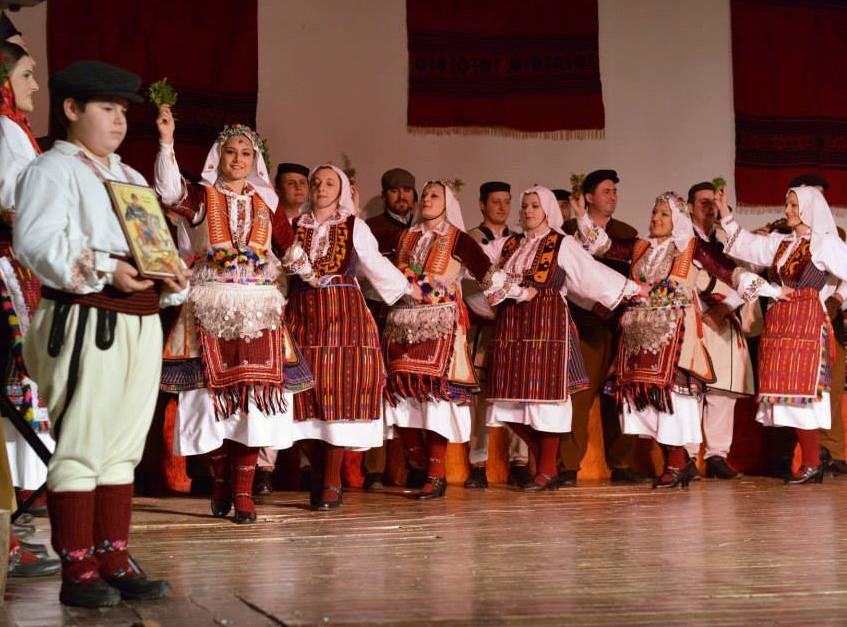
(Gallery)
4. Kopacka – A native popular dance
Scene setting: Jovica Blazhevski
“Kopachka” is originally a male dance that according to classifications falls into the assembly dances. It comes from the ethnographic region of Pijanec or S. Dramche, Delchevo. Characteristic of this dance is the way of dancing- it is danced on the entire sole of the foot, in a rapid pace and the instruments which are played, the drums. The dance includes four dancing patterns taken from four folk dances "Shetanica", "Sitno", "Prefrlachka" and "Kopachka".
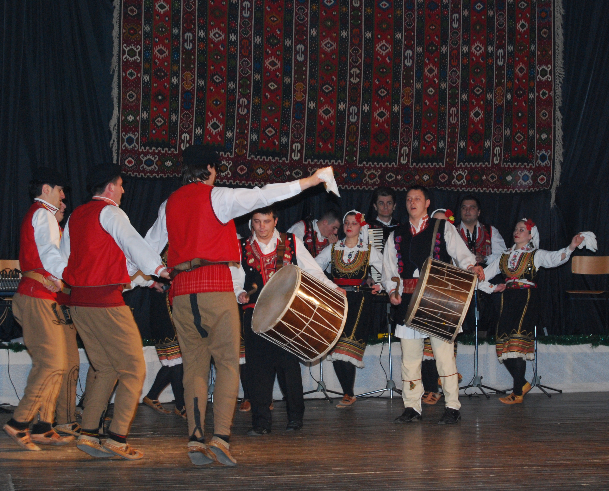
(Gallery)
5. Vevchani Vasilica dances
Stage adaptation: Tosho Chochoroski
Music Processing: Pero Peshinoski
A dance in which in an original form are transmitted authentic melody, steps, techniques and rituals that still are danced on St. Vasilija Feast. It originated from Vevcani, and according to the content and purpose belongs to the category of ritual dances under masks.
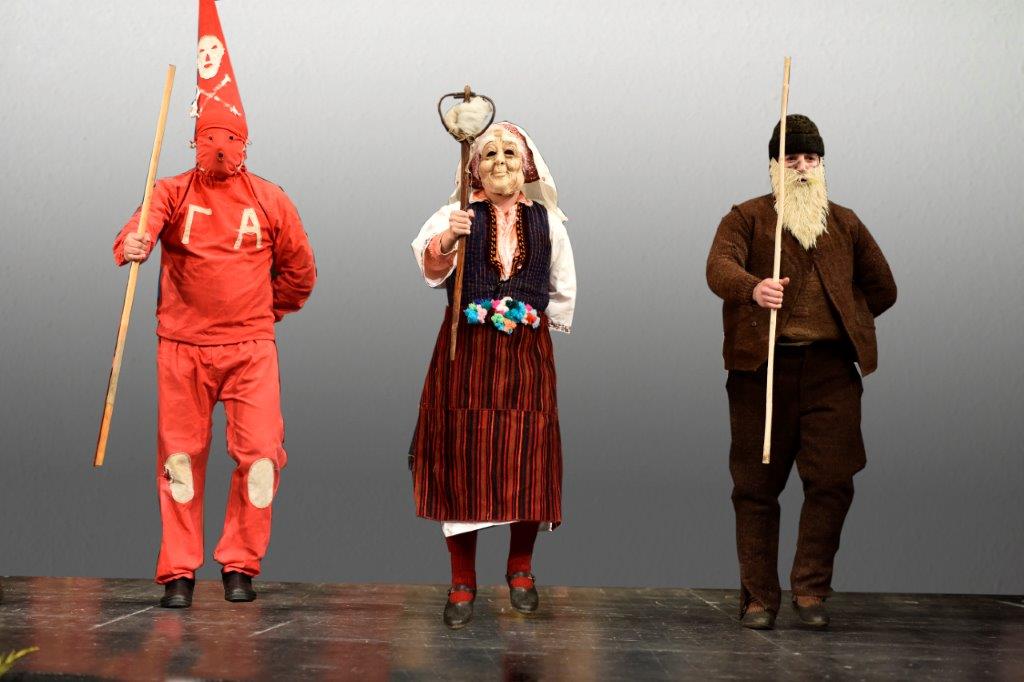
(Gallery)
6. Gluvonemoto (k`lc noga) (deaf-mute)
Stage adaptation Snow White Balkan
Female dance, performed without musical and vocal accompaniment.
Stomping with the feet and jewellery jingling create a rhythm which accelerates in accordance with its progression. This is a female dance which is played on the wedding day the bride. The stomping of the feet symbolizes stability, the contrentration and slow pace that is felt during the performance symbolizes the bride’s humility and respect for the new home and family.
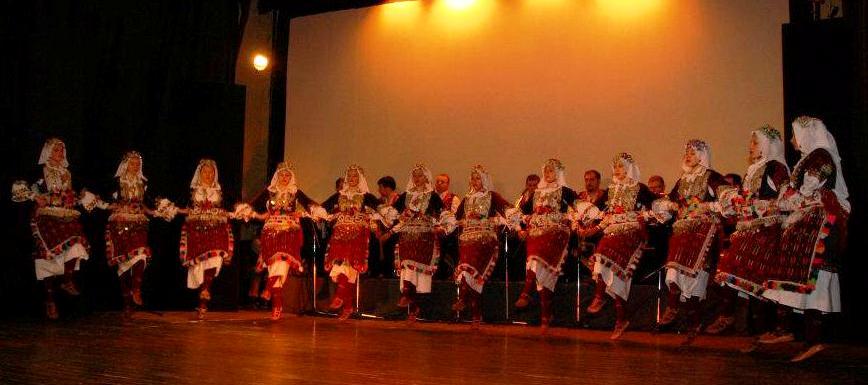
(Gallery)
7. Isteruvanje na chumata ( The Expulsion of the Plague)
Processing choreography: Todor Jovanov
Music Processing: Todor Jovanov
Stylized ritual mixed dance, inspired by the disease plague that has historically been transmitted by rodents and fleas, to which people often attributed supernatural forces and powers. It is performed in traditional costume from the Ovchepole region.

(Gallery)
8. Vevchanski svadbeni obicai (Vevcani marriage customs)
Stage adaptation: Tosho Chochoroski
Music Processing: Pero Peshinoski
Mixed dance in which through theater activities, dances and songs is presented the wedding ceremony as one of the most important moments in the life of every person, containing all important elements, customs and rites of passage that are characteristic of the Vevcani wedding ceremony.
In staging the dance are used songs and dances that are danced and sung during weddings in Vevcani.

(Gallery)
9. Vodarki (women fetching water)
Choreographic processing: Blaze Palcheski
Muse Musical processing: Gjorgi Dimcheski
Assembled female dance which represents a part of everyday life of the Macedonian woman, or fetching water at the village fountain.
The dance is composed of several elements and dances from different regions in Macedonia.
In the dance are presented a larger number of elements from Eastern Macedonia, and is commonly performed in folk costume from Dolni Polog.
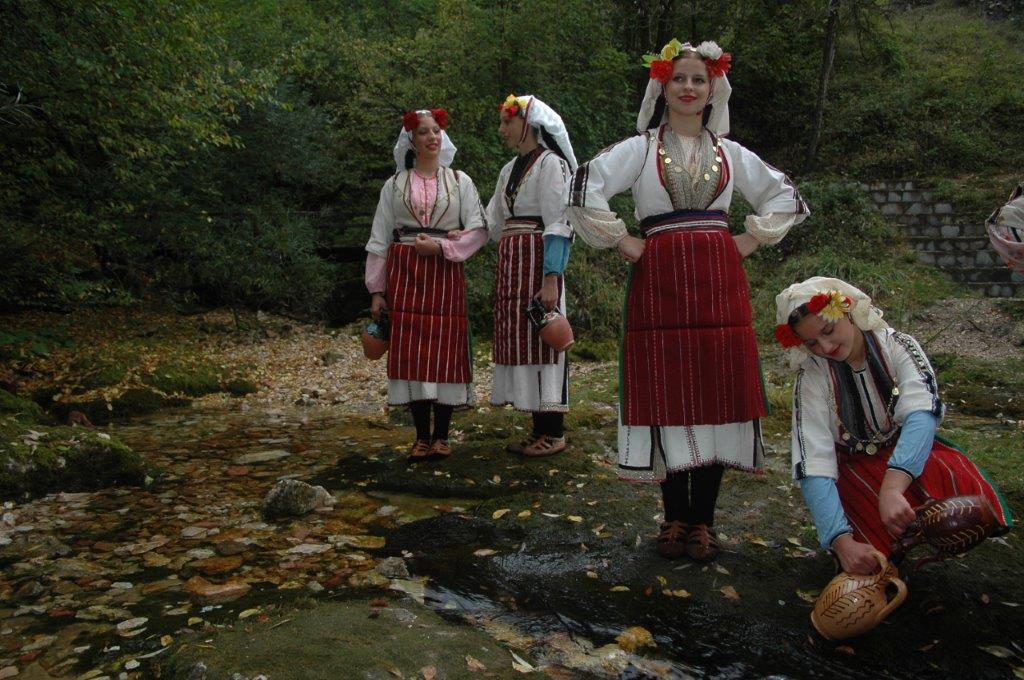
(Gallery)
10. Drachevka
Choreography processing: Atanas Kolarovski
Music Processing: Trajko Prokopiev
A folk-dance originating from the area of Blatija Skopje and Skopska Crna Gora. Performed in varieties of costumes from the same area. The dance represents the joy of the village council through dramatic actions, rhythmic songs and dances, specific stylistic features of dances from the Northern Foklore Dance area.
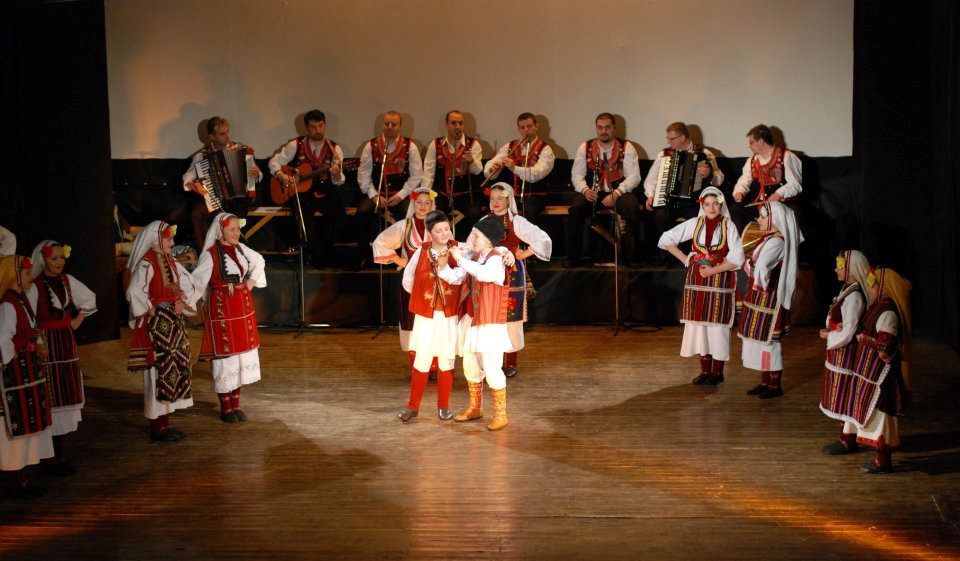
(Gallery)
11. Eremya (St. Jeremiah)
Stage adaptation: Natasha Kukoska
Without music accompaniment
The scenic adaptation titled "Jeremja" falls into the category of childrens’ games with ritual character. It is performed by children of mixed gender-structure. The game is a scenic reconstruction and adaptation of traditional experiences and behavior during the performance of the ritual practices on the feast of St. Jeremiah.
The paraphernalia used to capture the authenticity, pans, various bells etc. is a kind of orchestra for the dance, noinstruments, the steps are result of rendom melodic sounds.
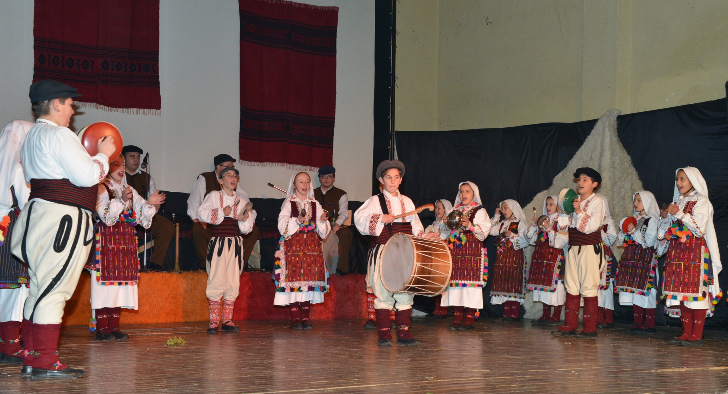
(Gallery)
12. Folk dances from Bitola
Choreographic processing: Stojanche Karanfilov
Music processing: Milan Zafkov
This dance includes fragments of the dances "Beranche" "Bufchansko", "Pajdushko", "Beda", "Gajda", and the dance-leading song "Otishla Jana na niva." It is performed in a traditional costume from the Bitola region.
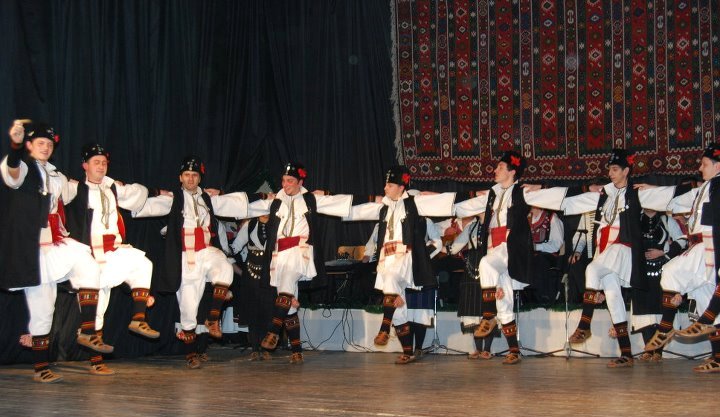
(Gallery)
13. Vodicharki
Stage adaptation: Svetlana Cirich
Music Processing: Dragan Dautovski
This dance is inspired by female ritual processions that go from house to house and sing appropriate ritual songs designed to bring health and prosperity to each family member in that year.
Vodicharki is a stage adaptation of the practices related to the Epiphany or St.John from the region of Skopska Blatija, village Bulachani.
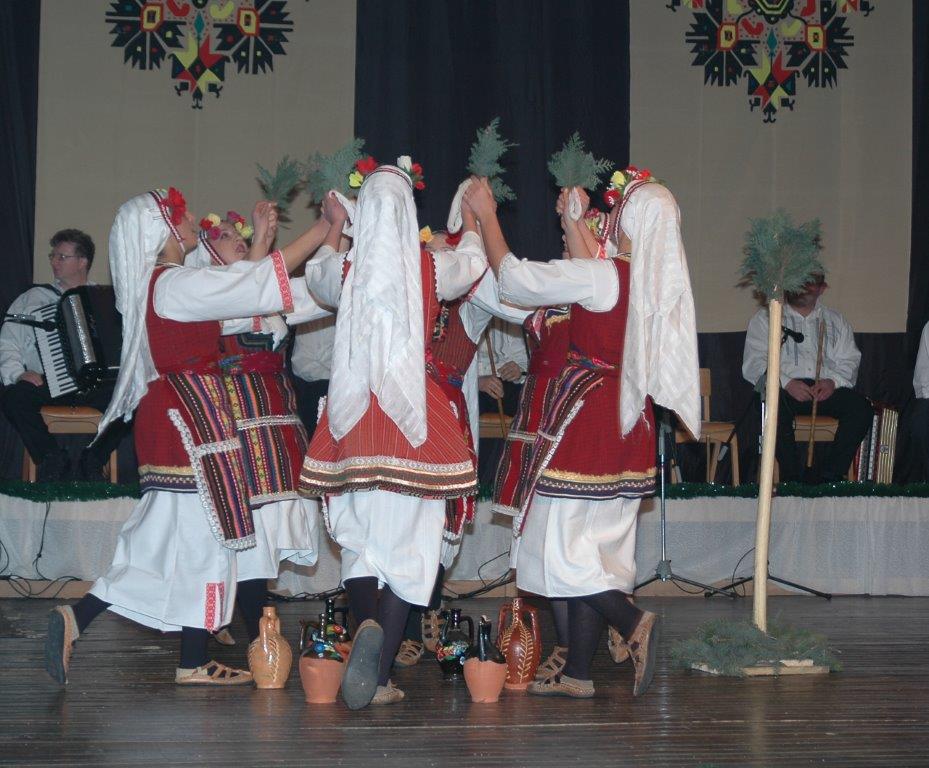
(Gallery)
14. Kopachija
Choreographic treatment: Stojanche Karanfilov
Music processing: Milan Zafkov
A mixed dance that bears the name of the area where originated, Kopachija, an area around the town of Kicevo. The game itself include the following dances: "Svekrvino" (female dance), "Malesora" (male dance), "Krstachko", "Chetvorla" and the song "Angelino Mome."
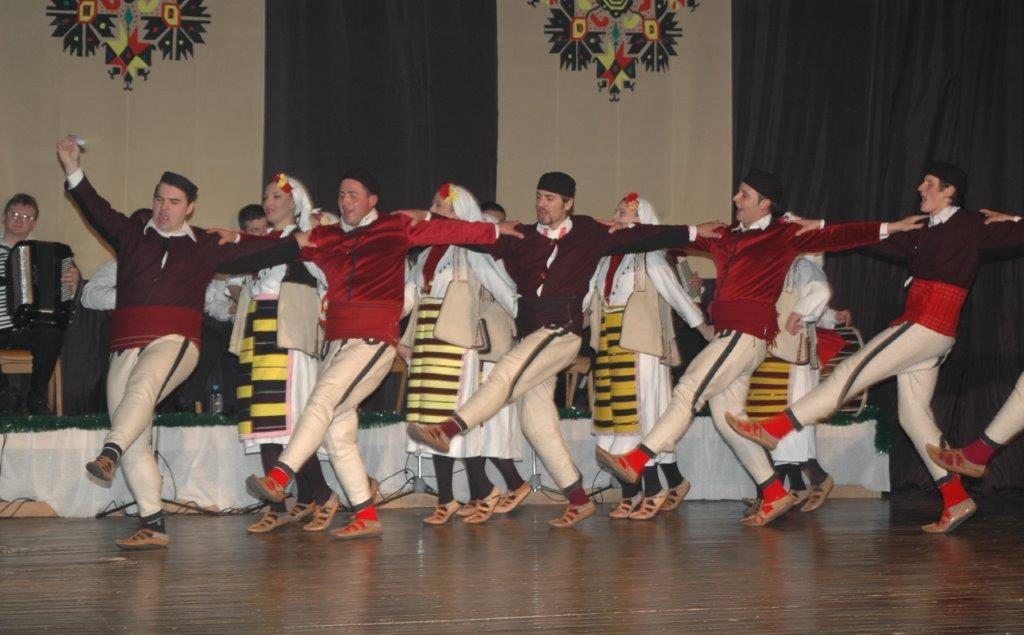
(Gallery)
15. Dodolki
Stage adaptation: Natasha Kukoska
Without musical accompaniment
The stage adaptation is inspired by the ritual "Dodole", "Oj lilesh" or "Ojlileshki" which is carried out at any time of the year when rain is desired. A larger group of girls aged 5 to 15, disguise in ‘dodolki’ , and singing appropriate songs, they pray for rain. A girl from the group stands out and puts on an old female costume on top on the one she wears everyday. Other girls adorn her with ‘ bear’s foot’ and put a wreath on her head, then, they splash her with water carried in "kettles" or "gjumchinja". They do it in each yard of the village. The songs they sing, basically, contains prayer to God to send rain.
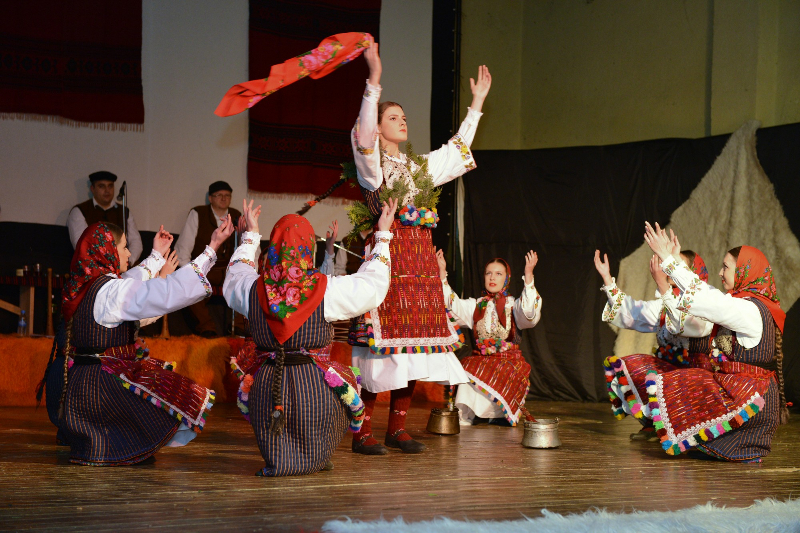
(Gallery)
16. Bukite i posednica
Stage adaptation Vladimir Janevski
Music: Folk
"Bukite" is a ‘town female’ dance, while "Posednica" a male dance, originating from Voden and Meglen- Aegean Macedonia. It is performed in an urban national costume.
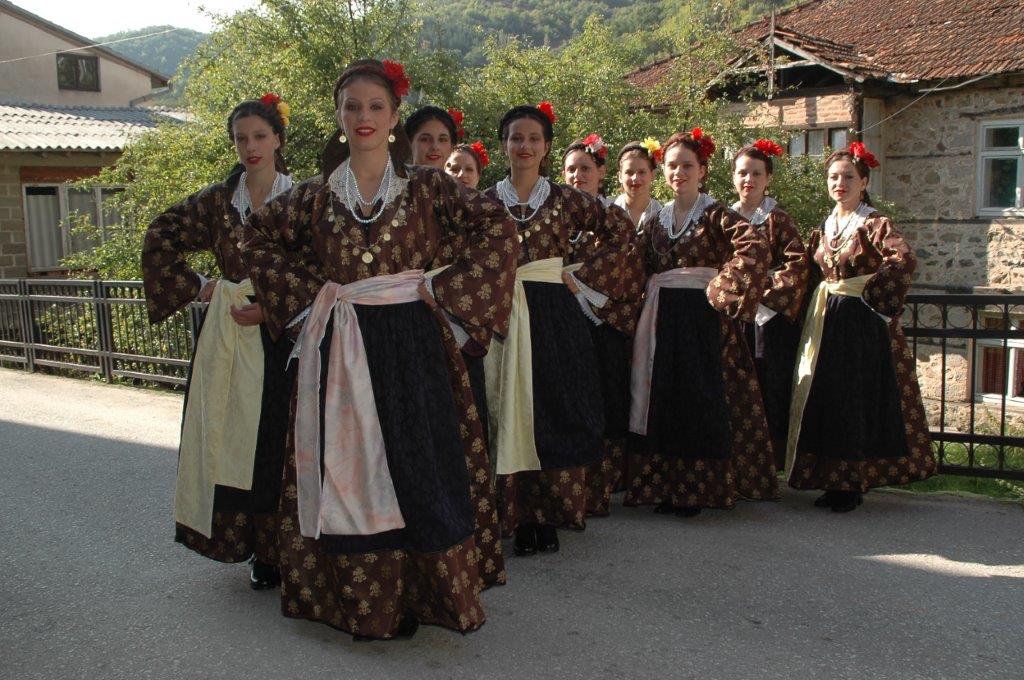
(Gallery)
17. Mariovska Tresenica
Stage adaptation: Jonche Hrostovski
Musical processing: George Dimcevski
A stylized female dance which basically consists of the steps of "Buvchanso dance". The name of the dance coincides with the playing style of the dance itself, and as a motif is taken Clean Monday - the day when women used to clean their houses getting ready for the big fast.
The dance is performed in the traditional costume of the Mariovo region.
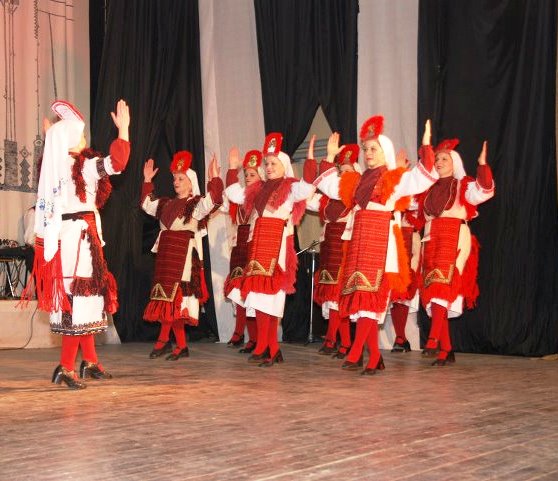
(Gallery)
18. Dances and songs of Eastern Macedonia
Selection of dances and songs adapted for the stage by Tosho Chochoroski
Music Processing: collective – the Orchestra of CAA "Drimkol"
It is a mixture of songs and dances originating from parts of Eastern Macedonia, i.e. ethnic areas of Shopsko-Macedonian ethnographic unit: Pchinja, East of Slavishte, Durachka River, Kratovo, Pijanec, Maleshevo, Ovche Pole, the area of the upper course of the river Vardarska ethnographic unit: Zhegligovo, Sredorek and western part of Slavishte, as well as a part of the central Macedonian ethnographic region including Azot and the villages of Upper Veles and have characteristics of eastern folklore dance region, with strong, quick steps, following the rhythm, holding straps, shoulder and the like.
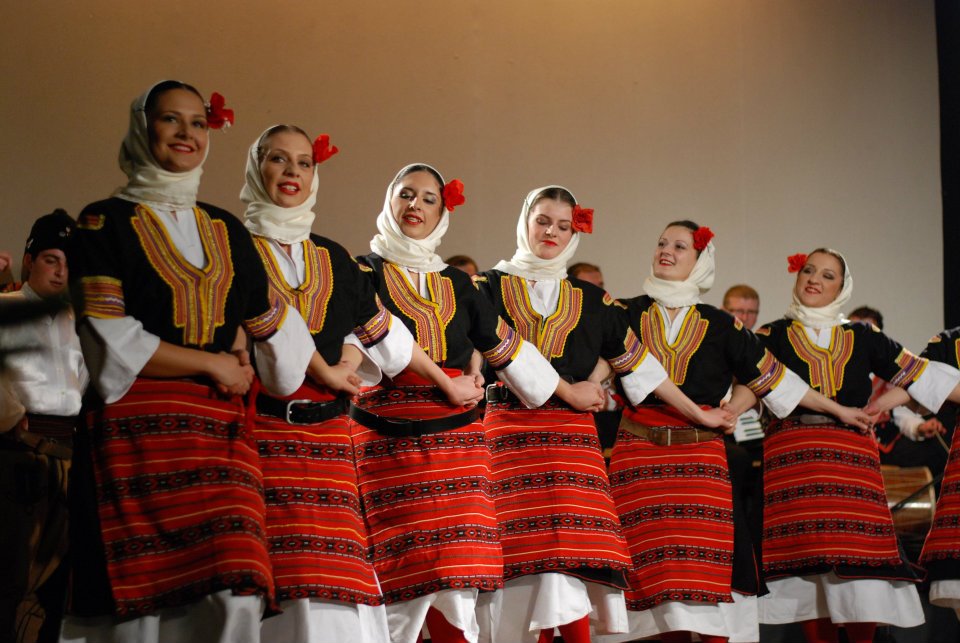
(Gallery)
19. Male Vevchani dance (Mashko vevcansko oro)
Adapted and staged by Tosho Chochoroski
Music Processing: Slave Kukoski
The inspiration for the author`s melodic dance "Kaaba" which has accommodated in Vevcani was played at weddings, celebrations, gatherings.
The author creates steps based on the melody and scenic solutions he transforms into a male dance, which by the classification belongs to the group of assembled dances. Represented are stylish features, that, according to the position of the hands- the dancers hold hands, there is a combination of slow, firm steps, which later according to the dynamics of the dance are accelerated.
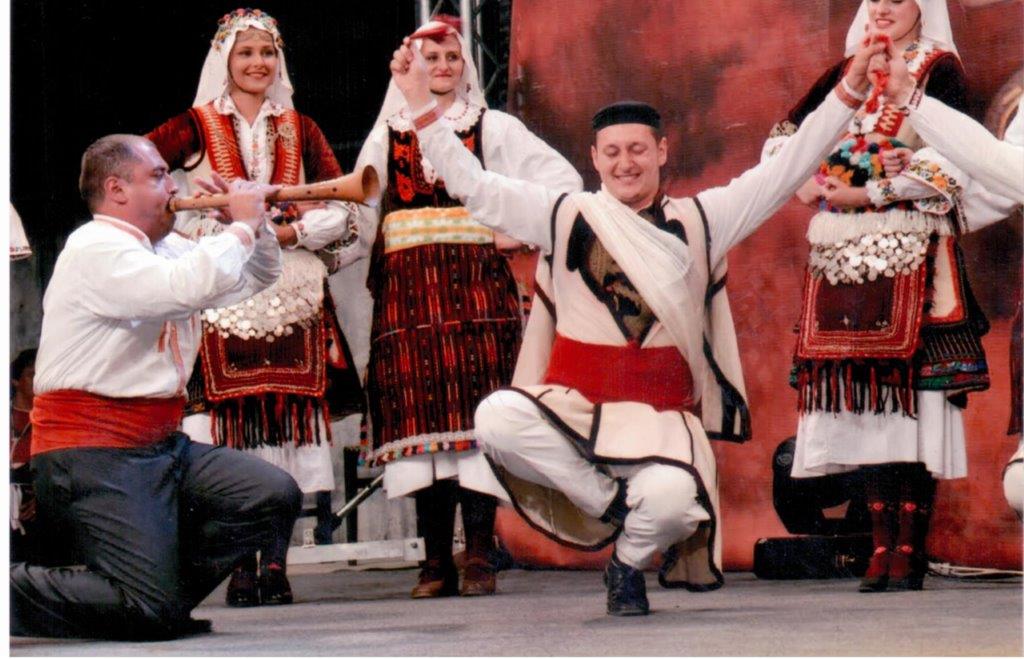
(Gallery)
20. Nevestinsko (Bride dance)
Stage adaptation: Trajko Prokopiev
Music Processing: Trajko Prokopiev
The stage adaptation is based on the melody of the traditional song "Prsten mi padna." The Bride Dance of vividly captures the preparation and the bridal dance of the bride and is accompanied her closest friends called "Drushki". This traditional dance captures the grace, dignity and beauty of the Macedonian woman..
It originated in the emigration area that stretches from the western mountain range to the region around Bitola.
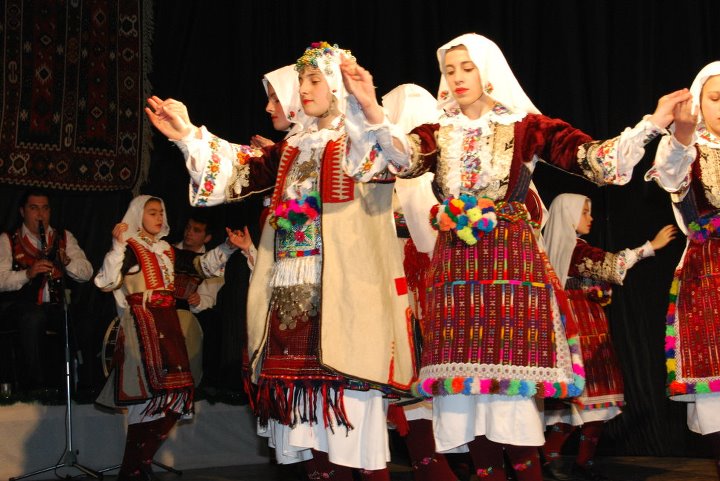
(Gallery)
21. Songs and dances from Ohrid
Stage adaptation: Tosho Chochoroski
Music Processing: collective – the Orchestra of CAA "Drimkol"
The choreography is based on the songs and dances which were sang and danced by the Ohrid town musica bands - troubadours in the old downtown of Ohrid. It is performed in town national costume.
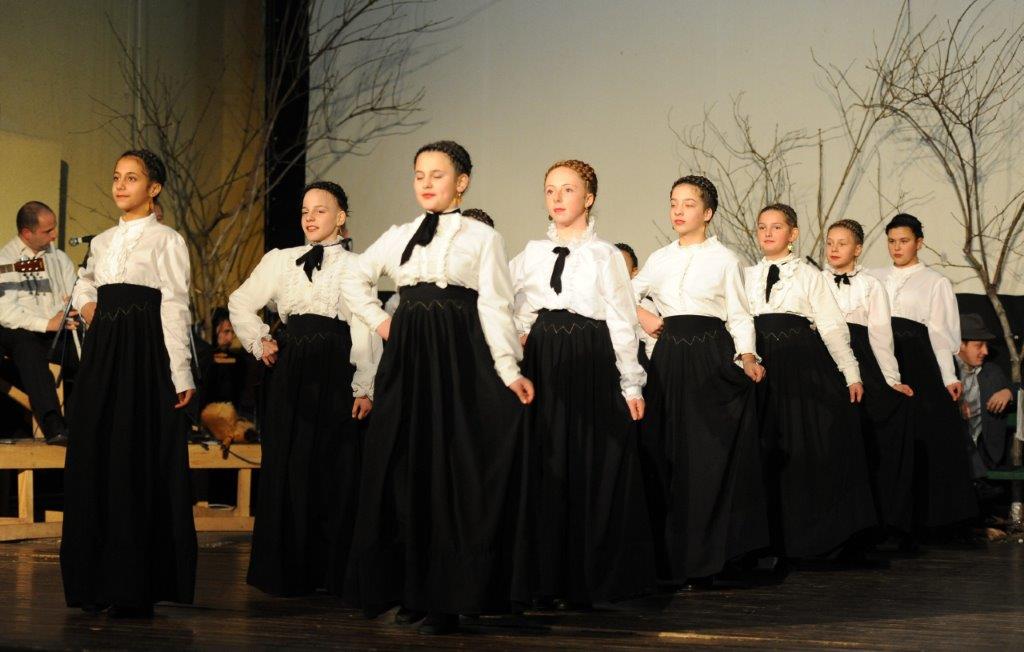
(Gallery)
22. Dances and songs from Aegean Macedonia
Selection of dances and songs adapted for the stage by Tosho Chochoroski
Music Processing: collective – the Orchestra of CAA "Drimkol"
The dances from Aegean Macedoniaare songs and dances of Southern Macedonia, known as Aegean Macedonia. The costumes of the assembly originate from the geographical area of the dances themselves. Songs are sung from many parts of the Aegean Macedonia such as the songs: "Krena Martinata", "Tvojte ochi Leno mori". Of the male dances "Mashkoto oro" (The Male Dance) is characteristic and it expresses the masculinity of the dancers by slow rhythm, stable and firm steps. This game falls under the classification of the dannces belonging to the southern folklore dances area.
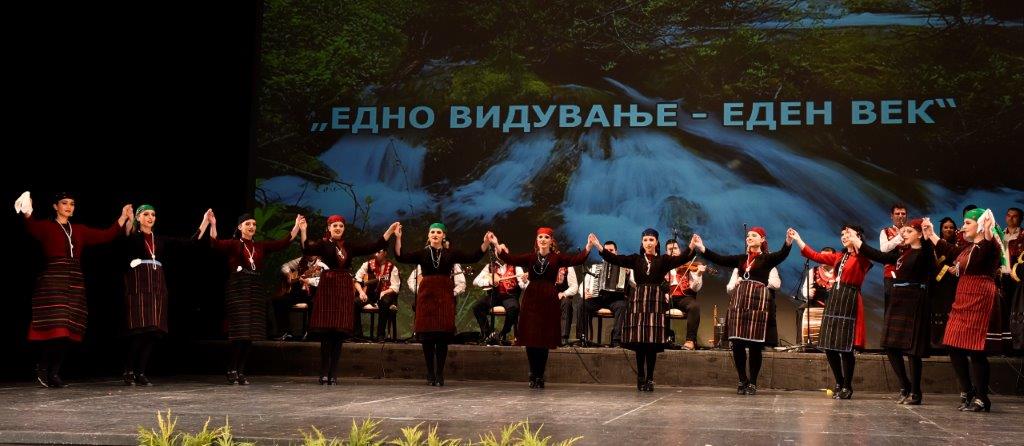
(Gallery)
23. Shrovetide (pokladi)
Stage adaptation: Natasha Kukoska
Music Processing: Slave Kukoski
Inspired by the rich customs and traditions associated with the holiday Proshteni Pokladi (Forgiveness) this stage adaptation is full of authenticity. The adaptation begins with the screening of the act of worship, asking forgiveness- the young bride asking the parents forgiveness, and the parents forgiving her. In the functioning of the ritual dance is integrated a particular ritual song "O Kerte, Kerte" which confirms the success and the ritual of the same. On the melody of the aforementioned song are created steps and scenic solutions. To display the authenticity, props such as "kertachki" are used authentic to the ones used to perform the rite in the practice. The scenic adaptation is perform by children of mixed gender.
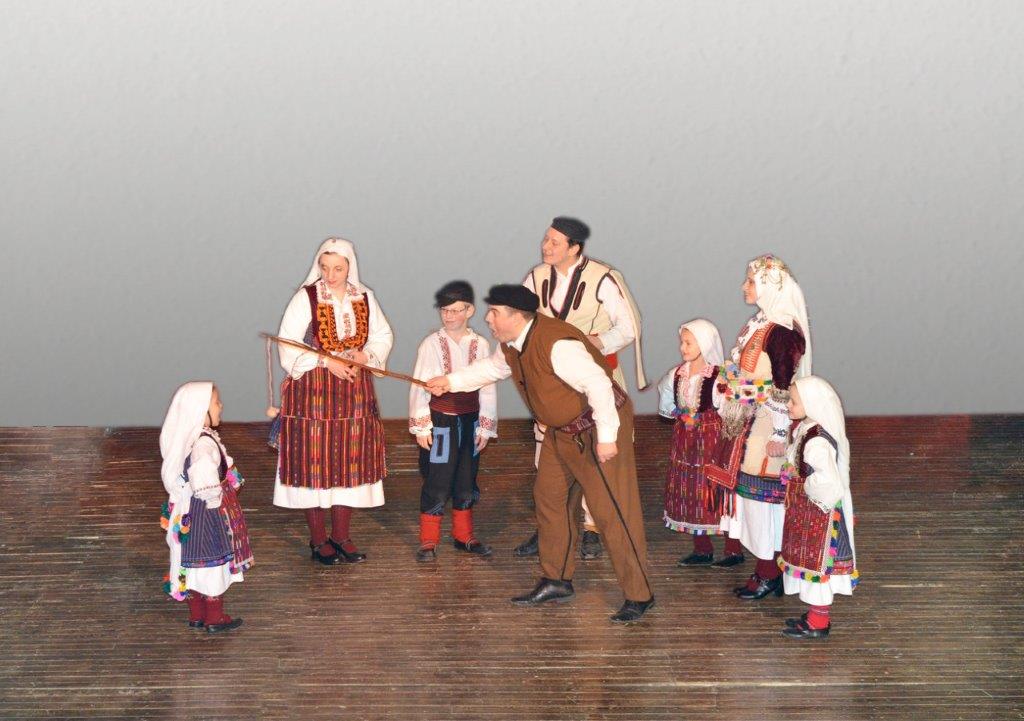
(Gallery)
24. Tropnalo oro
Choreographic treatment: Dusko GeorgievskiMusic processing: George Dimcevski
Mixed, male and female dance which through the dances "Tropnalo Oro", "Oroto Pochna," "Staro Tikvesh", "Kavadarka", "Crnogorka" is a kind of village gathering. This dance is a mix of folk dances and songs from the Skopje and it is performed in folk costumes from this area.
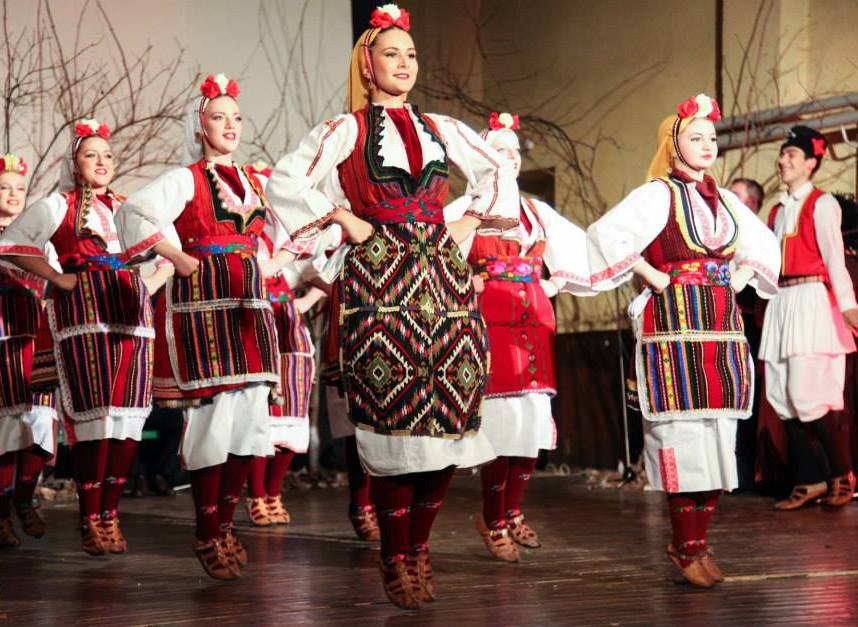
(Gallery)
25. Sveti Vjan (St. John)
Stage adaptation: Tosho Chochoroski
The dance is titled "St. Vjan." It integirates and displayes a number of rites and occasional songs accompanied by dramatic action.
Characteristic for this stage treatment is, that the songs, dances and ritual practices are performed in authentic form, i.e., without orchestra, the dances are played on songs, the songs are sung in the moment of dancing, in that, the whole ensemble takes part, thus providing the most authentic form of adaptation. The dances are performed only by male artists ordered by their age. The performance of this stage adaptation is a communication event between all the performers through a multitude of signs, like movements, mime, gesture, speech and songs. It creates a reconstruction of traditional experiences, behaviors and values during the celebration of the feast of St. John in Vevcani.
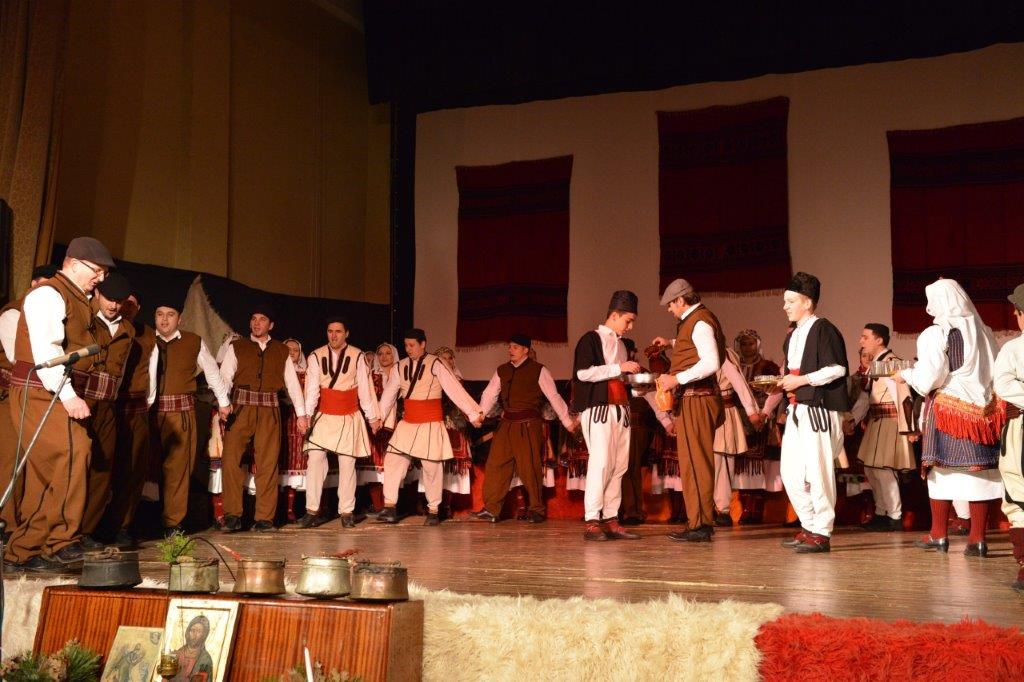
(Gallery)
26. Shopska Petorka
Stage adaptation: Cvetko Micevski
Music: Koco Petrovski
Stylized male dance which is performed by five dancers. The name of the dance originates from the people called Šops, who live in the triangle border regions of Serbia, Macedonia and Bigarija.
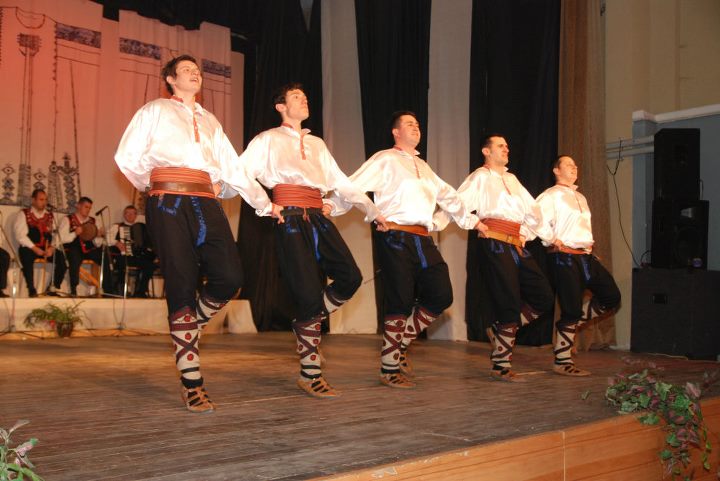
(Gallery)
27. Gjurgjovdenka
Choreographic treatment: Dojčin Matevski
Music treatment: George Dimcheski
Gjurdovdenka is a medley of folk dances and songs related to the biggest holiday of the spring cycle of holidays celebrated in Macedonia, St. George.
The main theme of the holiday are the prayers for health and fertility, and for that, girls and women danced and and sang songs on the subject. Men are only partially involved. While processing this dance songs, dances and costumes from the ethnographic region of Skopje Blatija are used.
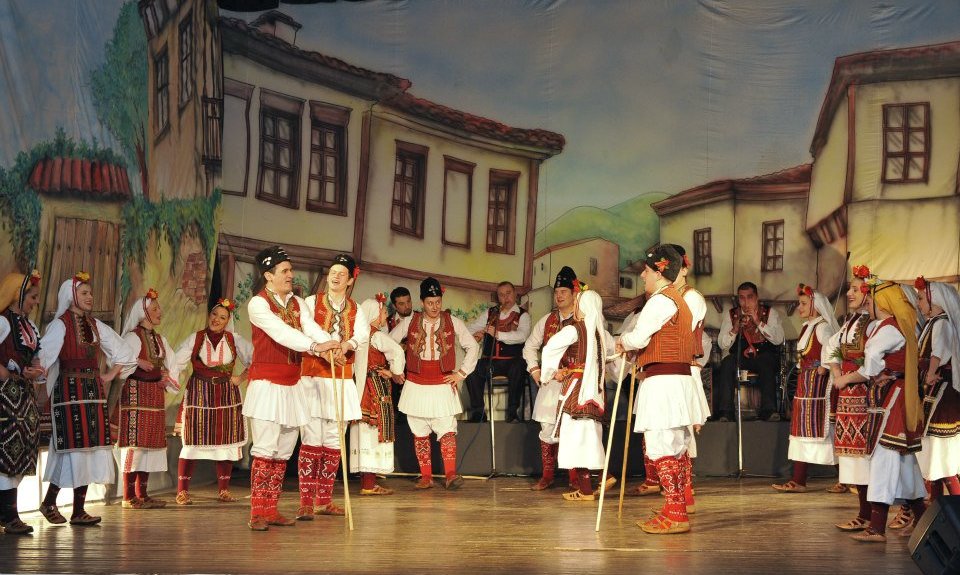
(Gallery)
28. Staro Bitolsko Oro (old Bitola dance)
Adapted and staged by Natasa Kukoska
Music: Folk
An ‘oro’ (folk dance) played by the town Bitola musicians (chalgiji). It is a female dance, in which, through slow steps is emphasized the grace, and beauty of the women from Bitola and Macedonian. The dance is known as "Vaj Vaj Pestref". The costume in which this ‘oro’ is danced is refered to as a town and costumes from the type of "A la Franga", worn in Bitola and other urban areas in the early 20th century in Macedonia.
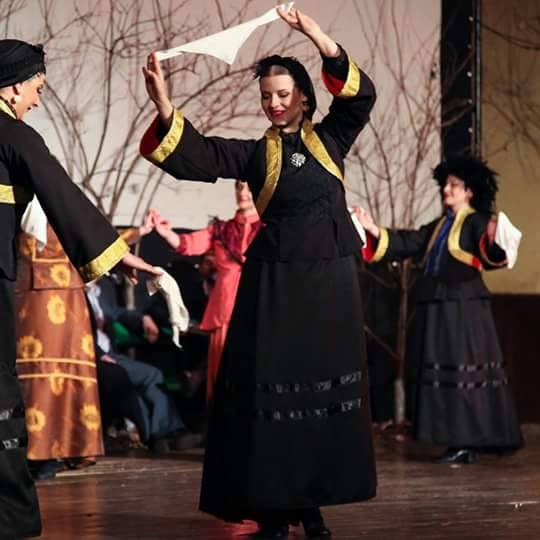
(Gallery)
29. Maleshevka
Choreographic treatment: Jovica Blazhevski
Music processing Sasho Mitev
Maleshevka is a dance inspired by the rich folk tradition the Maleshevo region. Through dramatic play one can sense the moment of courtship. Includes the folk dances: "Berovka" "Ispajche", "Pantevo", "Maleshevka" and the stylized song "Jano tenka Maleshevka". This dance is performed in a traditional costume from The Maleshevia.

(Gallery)
30. Narodno Oro (Peoples’ (folk)dance)
Choreographic treatment: Kiril Bebekoski
Music: Pece Atanasovski
The choreographic processing is inspired by the folk melody of the doyen Pece Atanasovski (begpipe). The choreographic staging represents a mixed dance of male and female dancers, and belongs to the cathegory of assembled dances. It originates from the ethnic region of Mariovo.
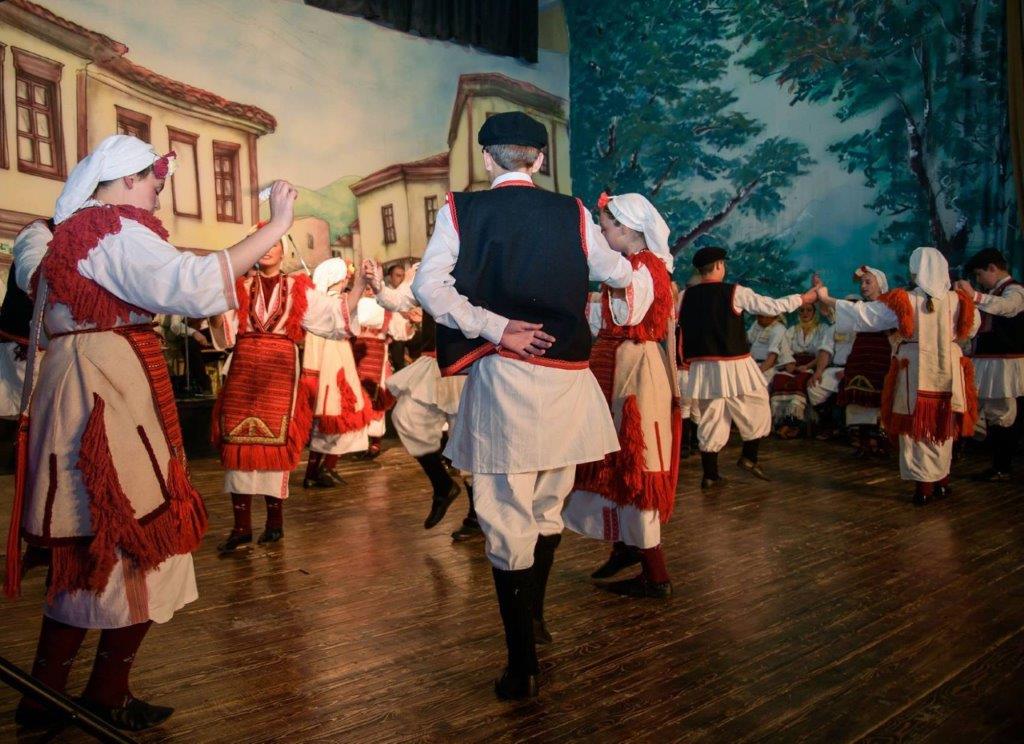
(Gallery)
31. Poreche dances
Choreography Processing: Todor Jovanov
Music Processing: Todor Jovanov
A stylized female dance inspired by the celebration of the Christian holiday Easter, from the ethnographic region of Poreche. The second day of Easter in the area was celebrated with dances and games danced and played exclusively by women.
In the Poreche region, in the dances are included in a stylized form elements from the dances "kalen broj malen broj" and "vili samovili".
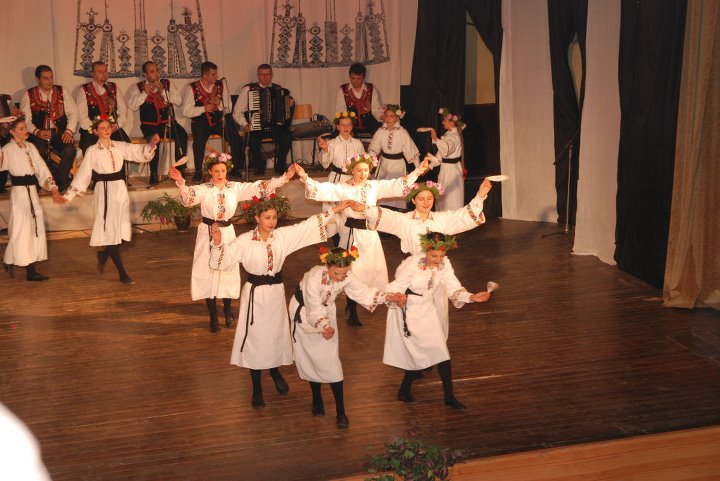
(Gallery)
32. Kumanovka
Choreographic processing: Jovica Blazhevski
Music processing: Milan Zavkov
A choreographic process abounding in stylish dance features for folklore dances typical of the northern region. As female stylish features are found fast, running steps highly balanced walk, leaps, greater freedom of the dance- stylistic expression, and men dance with highly balanced steps, squats, whirling individual dance. The whole abounds in songs and dances from the the Kumanovo area, after which it is named.
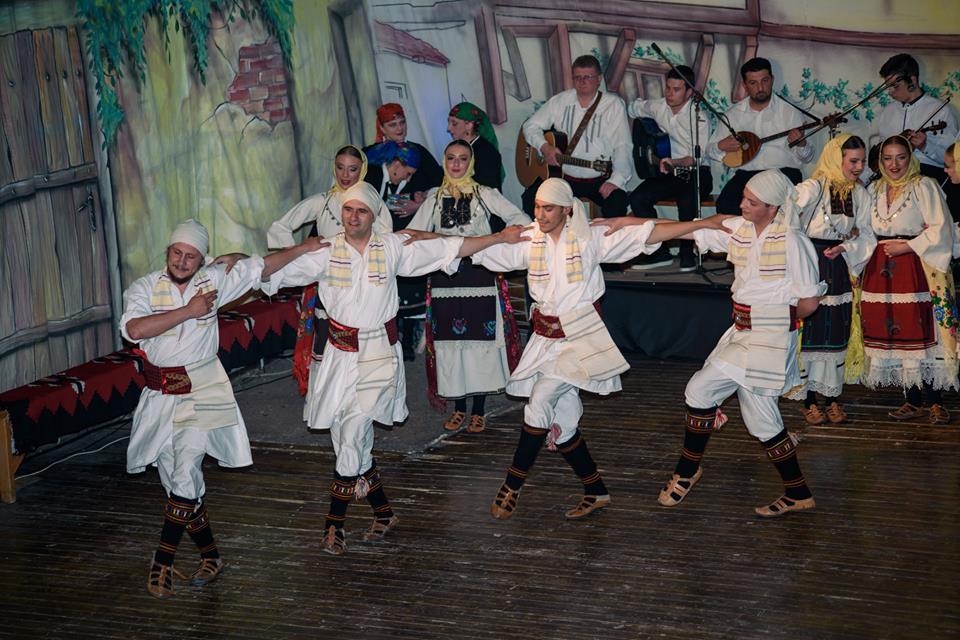
(Gallery)
33. Malo Prespansko Oro ( little Prespa Dance)
Stage adaptation: Natasha Kukoska
Music: Todor Trajcheski
A female dance based on the melodic folk dance “Malo Prespansko Oro”. In the dance are represented steps characteristic of Mala Prespa, simple dancing patterns, low steps, holding hands in the height of the waist. It is danced in the national costume of the ethnic region of Prespa.
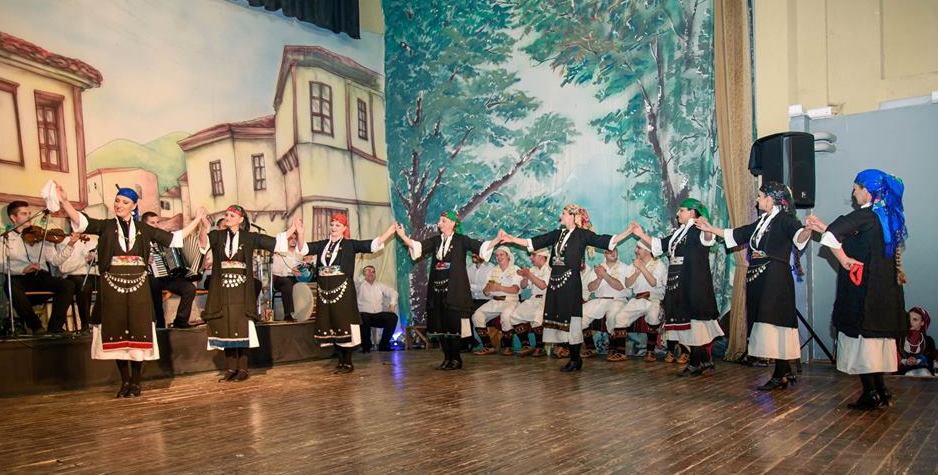
(Gallery)
34. Two dances
Choreographic adaptation: Vlado Stanoevski
Music Processing: Lazo Tropvski
The choreographic processing is inspired by the rich folk music of the region of Ovcepole and Kriva Palanka. It represents the outdancing of two groups of dancers. In the dance are included arrangements with new instruments which significantly affect the enrichment and stylization of the whole dance. This choreography is performed in a folk costume from the area where it originates.
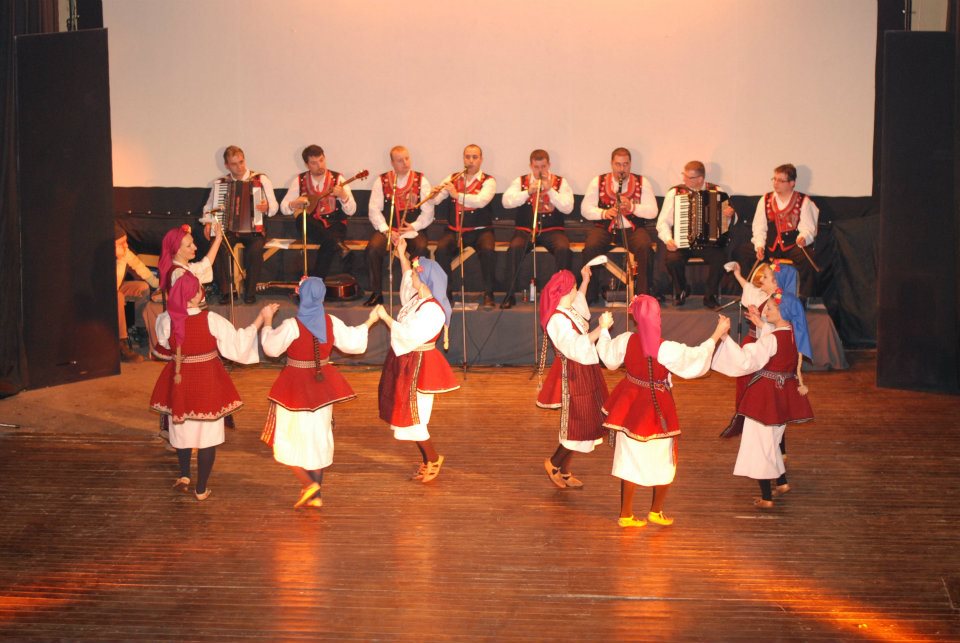
(Gallery)
35. Belchishko Oro
Adapted and staged by Natasha Kukoska
Music Processing: Slave Kukoski
A mixed dance from in the village Belcista, Ohrid. According to the form of this dance game is danced in a semicircular form, or semi-circle by adding easy steps that are processed on the melody of Belchisko dance.
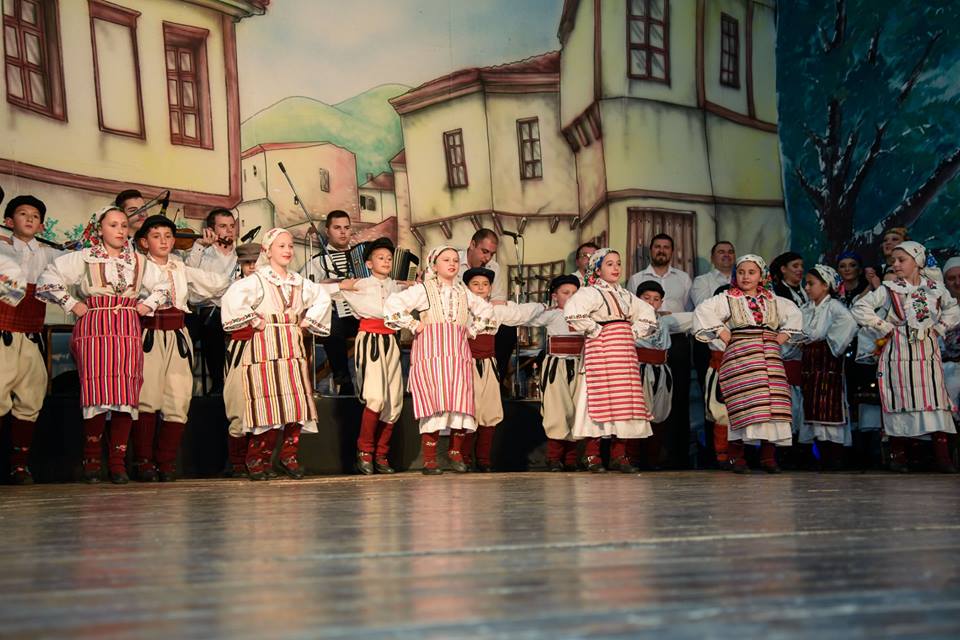
(Gallery)
36. Kasapsko Gradsko (town) dance
Adapted and staged by Natasha Kukoska
Music Processing: collective – the Orchestra of CAA "Drimkol"
An Ohrid, town female dance, inspired and processed on the melody of the famous "Kasapsko Oro".
It is danced in the Ohrid town costume.
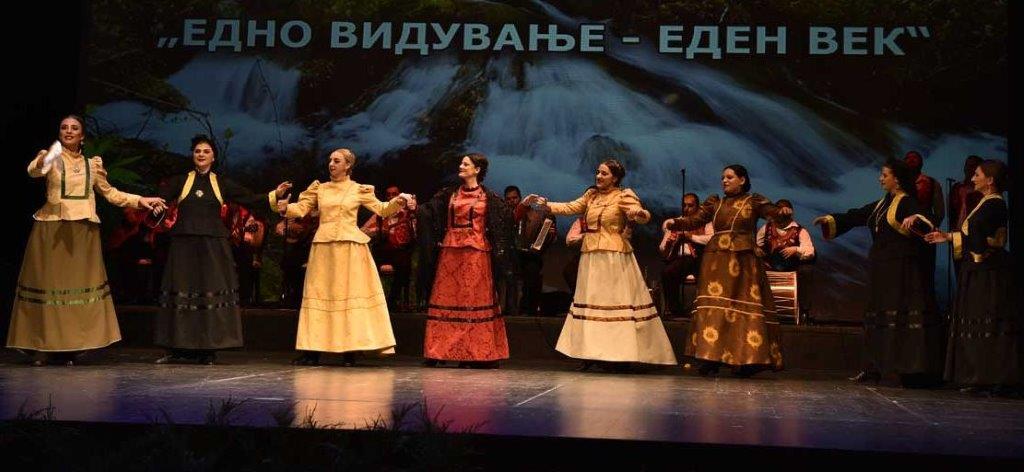
(Gallery)
37. Kavadarka
Choreographic processing: Dusko Georgievski
Musical processing: George Dimcheski
A male dance originating from Tikves, the Central Vardar region ethnographic subgroup. According to its origin, it is characterized with folk dance features of the Eastern region with dynamic steps and fast rhythm throughout the dance. It is performed in the men folk costume of the region.
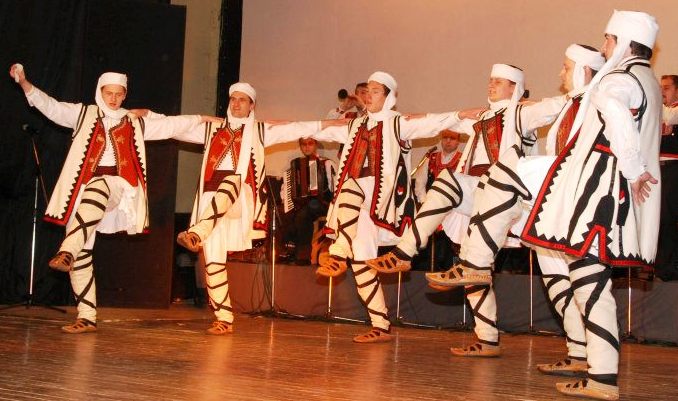
(Gallery)


